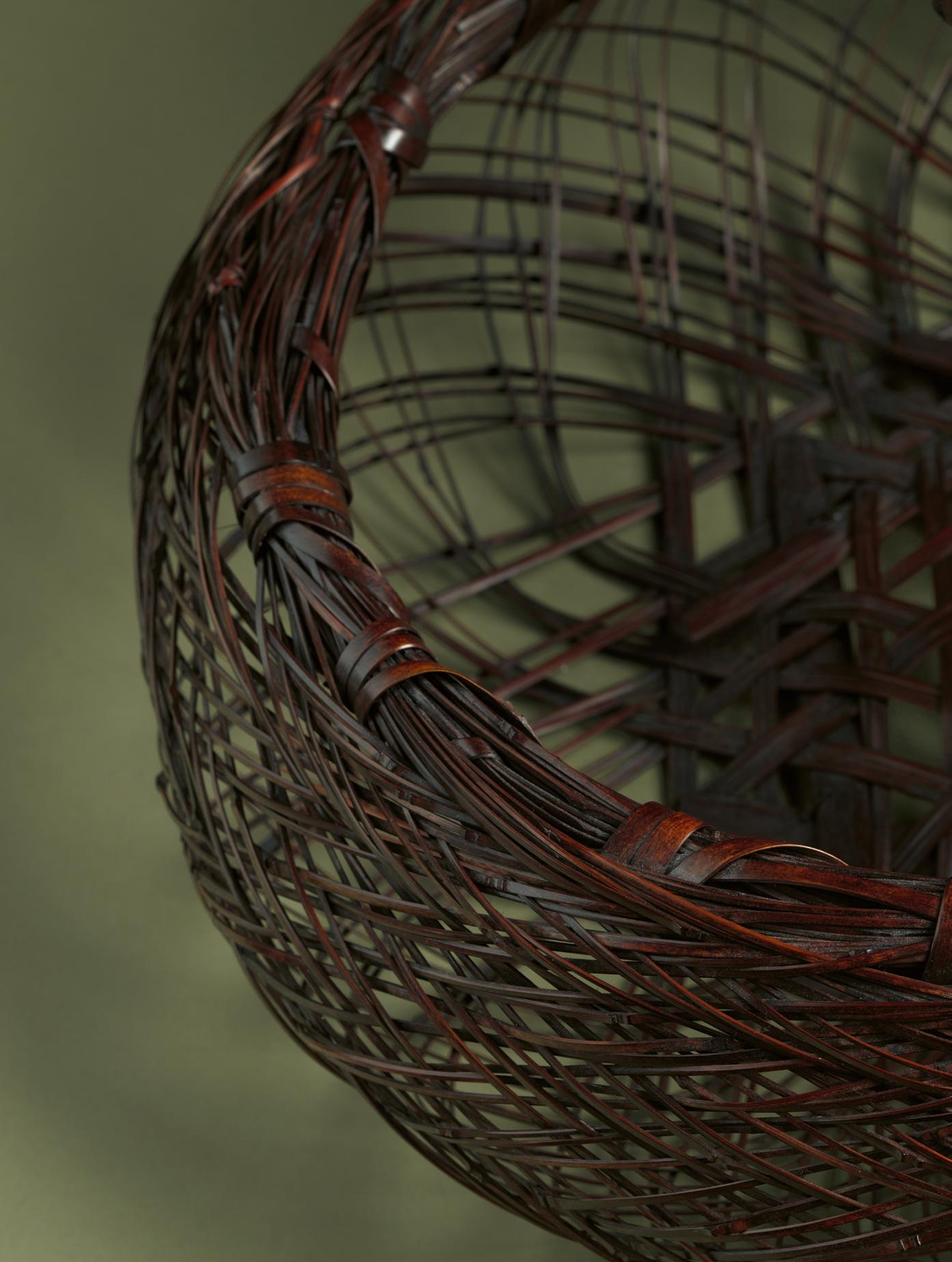Bamboo masterworks from Japan - classical to contemporary



ISBN: 978 1 873609 51 4
Design, Typesetting and Photography Daniel M. Eskenazi assisted by Massimo Eskenazi, London
Printed and originated by Graphicom Srl., Vicenza
© copyright 2023 ESKENAZI London
Bamboo masterworks from Japan - classical to contemporary
1 - 30 June 2023
10 Clifford Street
London W1S 2LJ
Telephone: 020 7493 5464
Fax: 020 7499 3136
e-mail: gallery@eskenazi.co.uk
web: www.eskenazi.co.uk
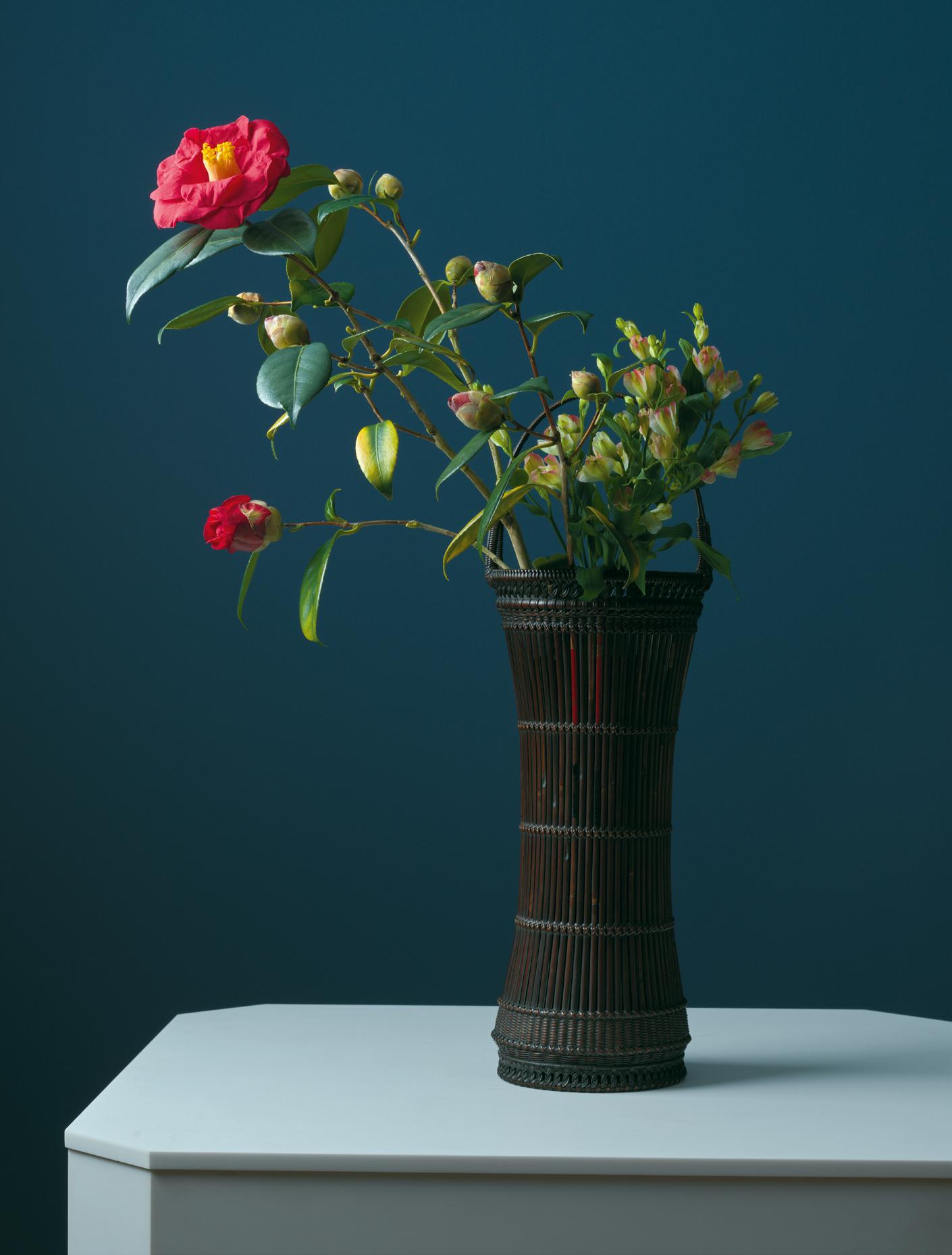
It is with great pleasure that we present our second exhibition devoted to bamboo works created by masters from Japan. The selection is predominantly contemporary but also includes baskets from the late nineteenth to early twentieth century. It is always informative to look back and explore the origins and influences on contemporary works and one of the reasons we have included these earlier pieces.
Many turn of the century Japanese bamboo baskets drew on earlier Chinese basketry and these were referred to as in ‘Chinese style’. This often implied classical forms with high handles and intricate plaiting. The contemporary works have combined traditional skills in new forms, sometimes to the point where they are no longer baskets but abstract sculptures. This progression can be seen in the four generations of the Tanabe Chikuunsai family and we are happy to have works from generation I, II and IV in the present exhibition. Tanabe Chikuunsai IV has more recently been known for his mathematical creations as well as large free-form large installations although the example in the exhibition (cat. 13) is perhaps more subtle in combining the old and new. Although by no means extensive , the gallery hopes that the above points come across with the eighteen artists represented here, all of whom show consumate skill and creativity using one of the most humble and plentiful natural media. In addition we are honoured to showcase the works of two past Living National Treasures in the field of bamboo, Iizuka Shōkansai (1919 - 2004) and Katsushiro Sōhō (b. 1934).
I would like to thank Sarah Wong for her captions and artist biographies. We have also appreciated the expertise of scholar, curator and author, Joe Earle. I would like to also thank Mrs Sumie Takahashi, master of ikebana, together with her devoted husband, for the flower arrangements, photographs of which are included in the catalogue. We hope you will be able to see some of her creations during the exhibition.
Daniel EskenaziBamboo masterworks from Japanclassical to contemporary
1
Tanabe Chikuunsai I (1877 - 1937)
Drum-shaped flower basket made from old arrow shafts
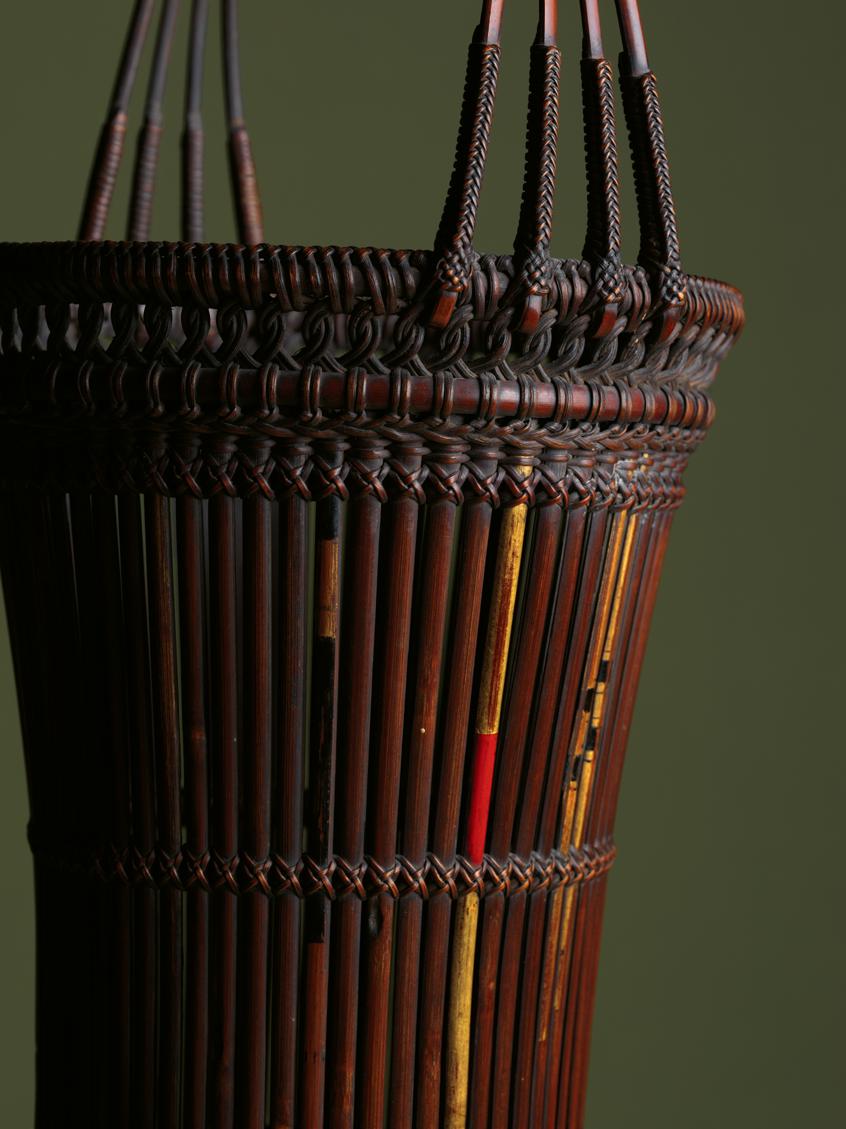
Signed: Chikuunsai made this
Split bamboo arrow shafts, rattan, gold leaf and red and black lacquer; mat plaiting, knotting
Height: 55.0cm
Width: 18.5cm
Depth: 17.5cm
Box inscription: Koyadake tsuzumigata hanakago (drum-shaped flower basket made from old arrow shafts); Sakaifu Nansō Chikuunsai kore o tsukuru (made by Chikuunsai of the Nansō Studio in Sakai); Seals: Denjō no in (seal of Denjō), Chikuunsai

Tanabe Chikuunsai I (1877 - 1937)
Flower basket with natural bamboo-root handle
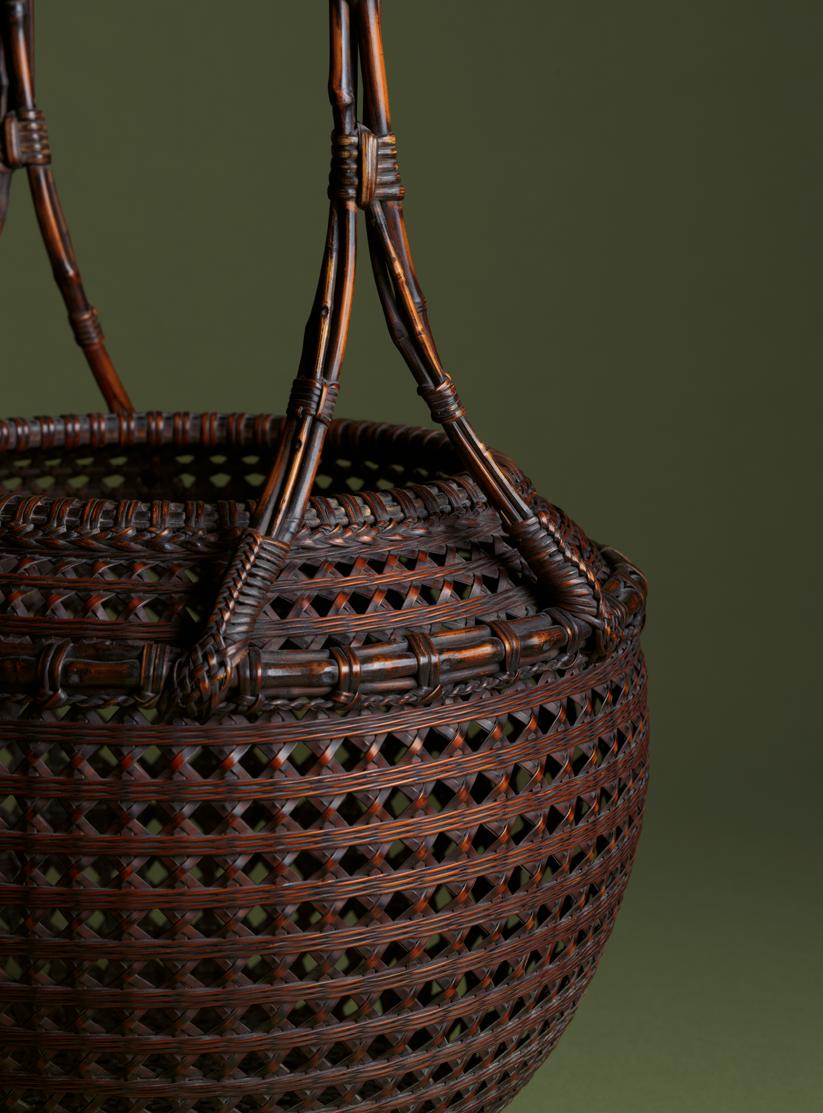
Signed: Made by Chikuunsai
Madake bamboo, rattan and bamboo root; square plaiting, twining
Height: 51.5cm
Width: 29.5cm
Depth: 29.5cm
Box inscription: Chikkonte hanakago (basket with bamboo-root handle); Chikuunsai kore o tsukuru (Chikuunsai made this); Seal: Chikuunsai

Tanabe Kōunsai (1898 - 1987)
Suehiro ( Burgeoning Prosperity ) flower basket
Signed: Kōunsai made this
Madake and nemagaridake ( hōbichiku ) bamboo, rattan and lacquer; twined square plaiting overlaid on diagonal plaiting, knotting, bamboo-root handle
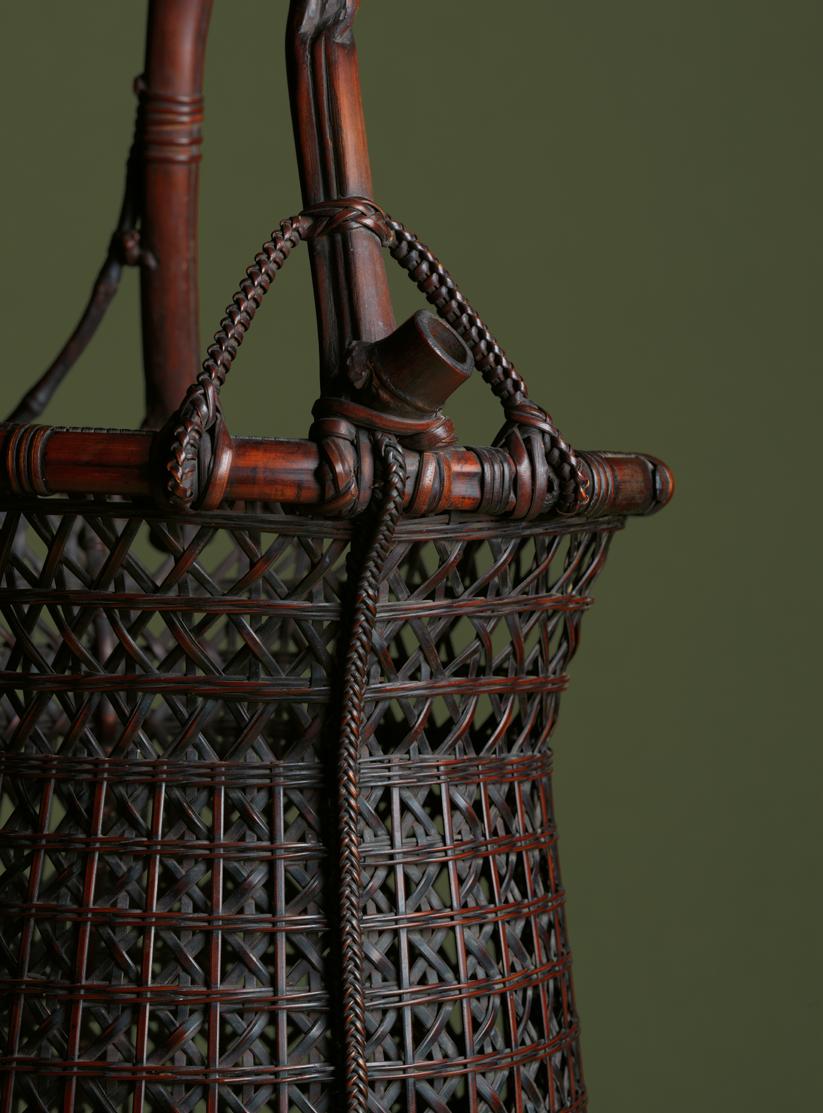
Height: 46.3cm
Width: 23.5cm
Depth: 21.0cm
Box inscription: Aioi-ami suehiro hanakago (double plaited flower basket with splayed mouth); Chinu-ura no jū Kōunsai kore o tsukuru (Tanabe Kōunsai of Chinu-ura made this); Seal: Kōunsai
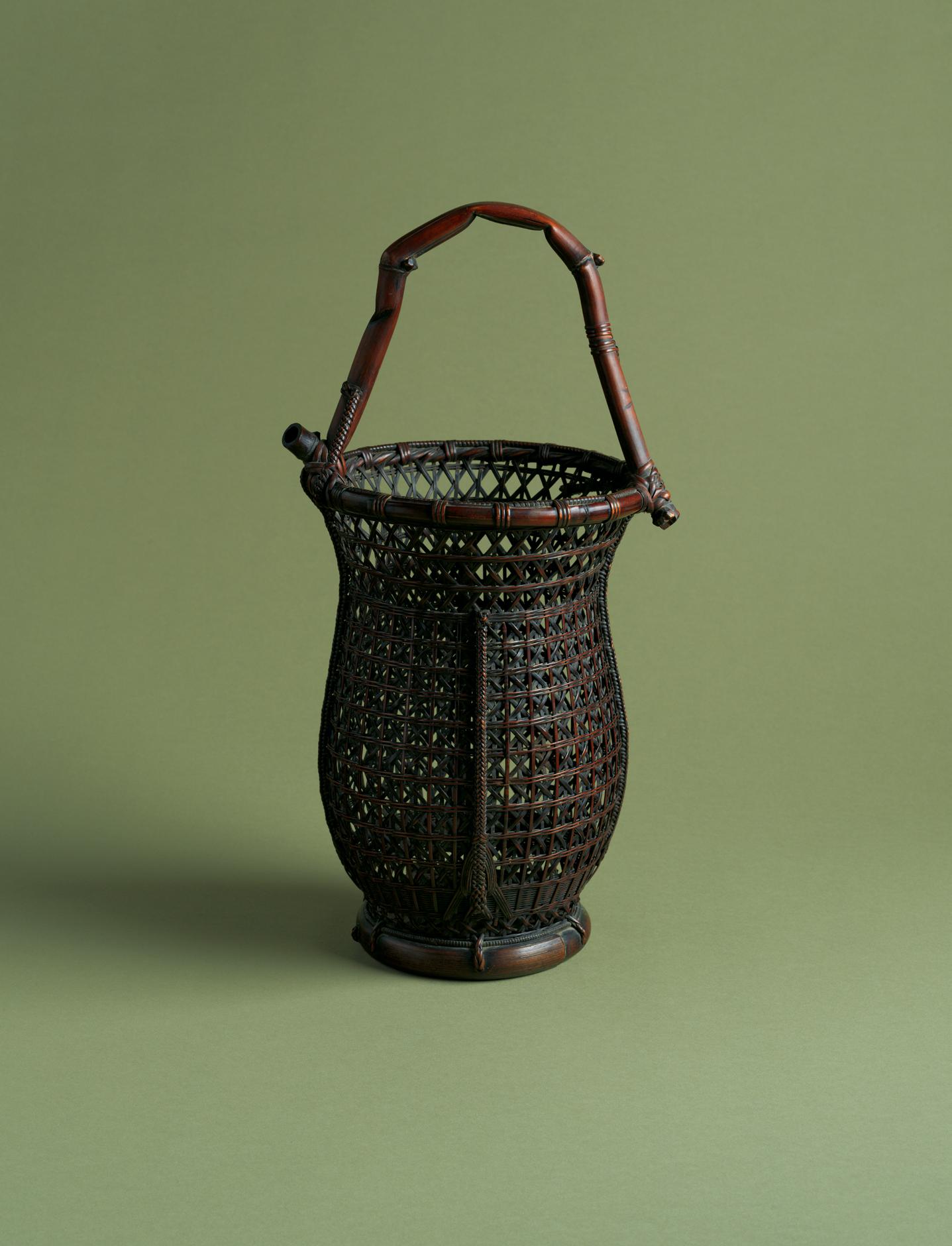
Tanabe Chikuunsai I (1877 - 1937)
Kyūsei ( Long Life ) fruit basket , ca. 1919

Signed: Chikuunsai made this
Madake and nemagaridake bamboo , susudake (smoked bamboo) and rattan; twill plaiting, radial plaiting, knotting, bent natural bamboo handle
Height: 32.3cm
Width: 37.5cm
Depth: 37.5cm
Box inscription: Kyūsei kudamonokago (Long Life fruit basket); Sakai ura no jū Chikuunsai kore o tsukuru (made by Chikuunsai, living on Sakai Bay); Seal: Chikuunsai

5 Sakaguchi Sōunsai (1899 - 1967)
Hōbichiku fruit basket
Signed: Sōunsai made this
Hōbichiku bamboo, rattan and lacquer; circular plaiting, natural bamboo handle

Height: 23.0cm
Width: 32.0cm
Depth: 31.5cm
Box inscription: Hōbichiku kudamonobako ( hōbichiku fruit basket); Sōunsai kore o tsukuru (Sōunsai made this); Seal: Sōunsai
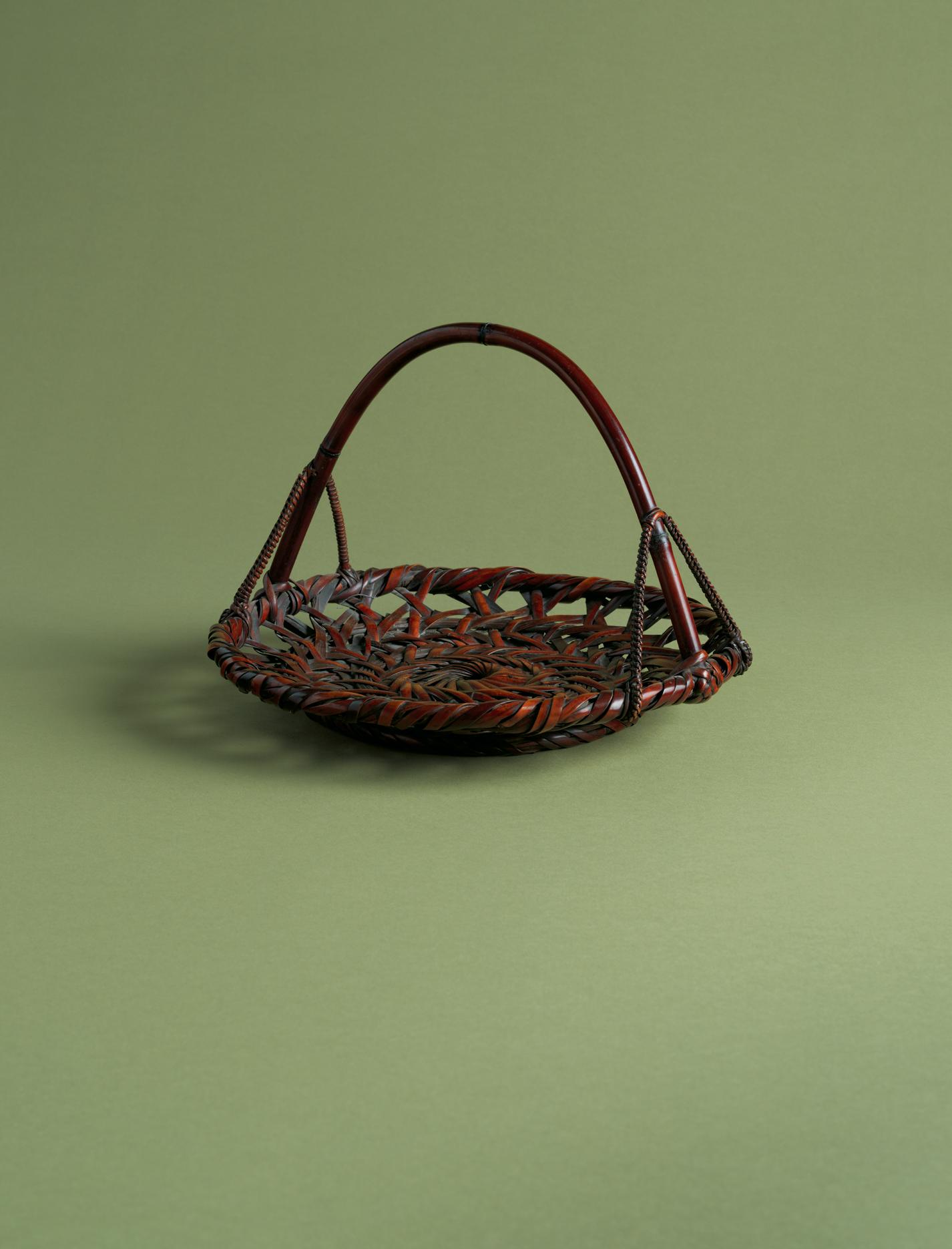
6
Tanabe Chikuunsai II (1910 - 2000)
Unryū ( Cloud Dragon ) handled basket for flowers, ca. 1925 - 1937

Signed: Shōchikuunsai made this
Susudake (smoked bamboo) and rattan; free-style plaiting, wrapping, bamboo-root handle
Height: 45.0cm
Width: 26.0cm
Depth: 25.5cm
Box inscription: Tennen chikute hanakago mei Unryū (flower basket named Cloud Dragon with natural bamboo handle); Shōchikuunsai kore o tsukuru (Shōchikuunsai made this); Seal: Shōchikuun
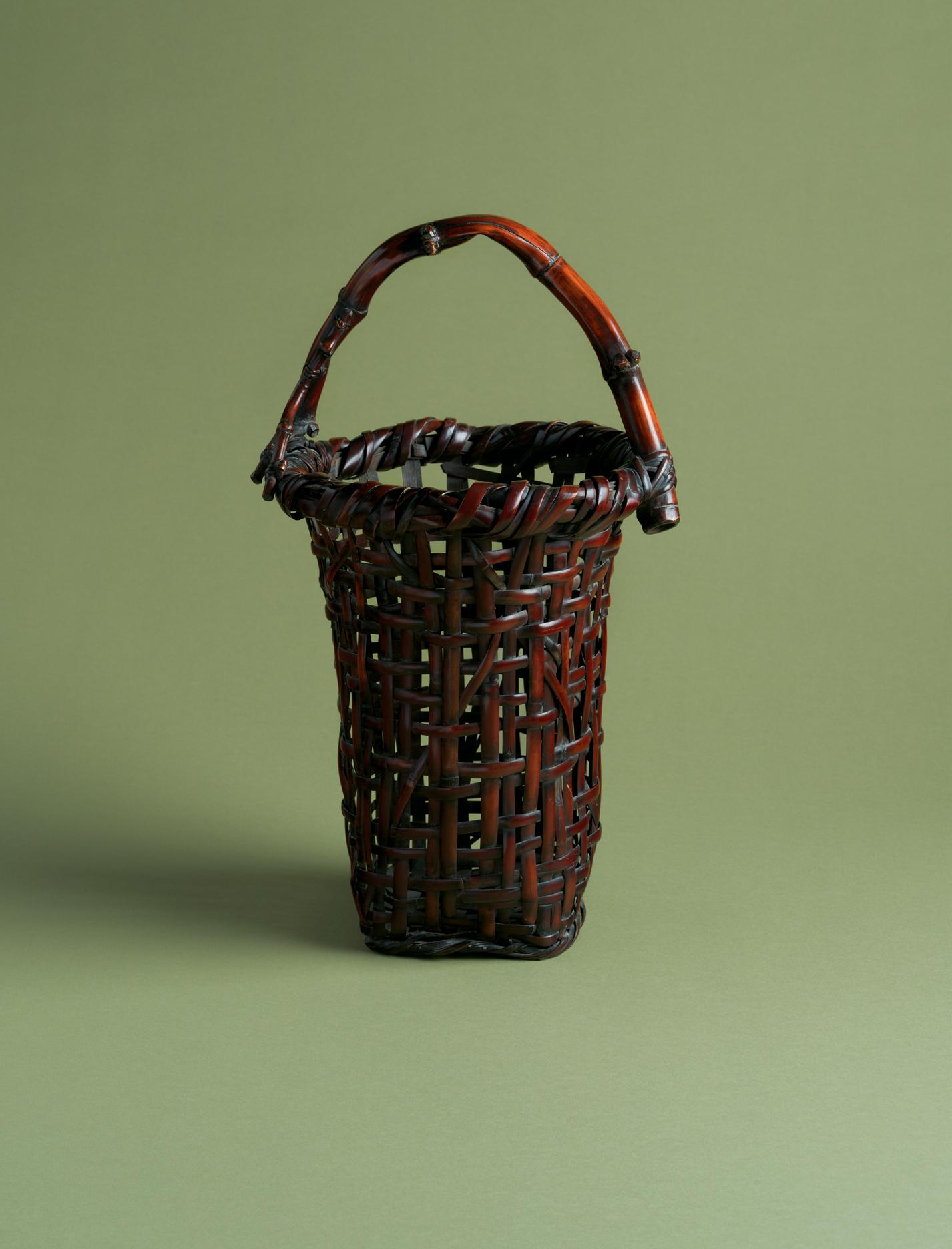
Tanabe Chikuunsai I (1877 - 1937)
Smoked bamboo flower basket bound in the style of a suit of armour with bamboo-root handle, 1922 - 1937
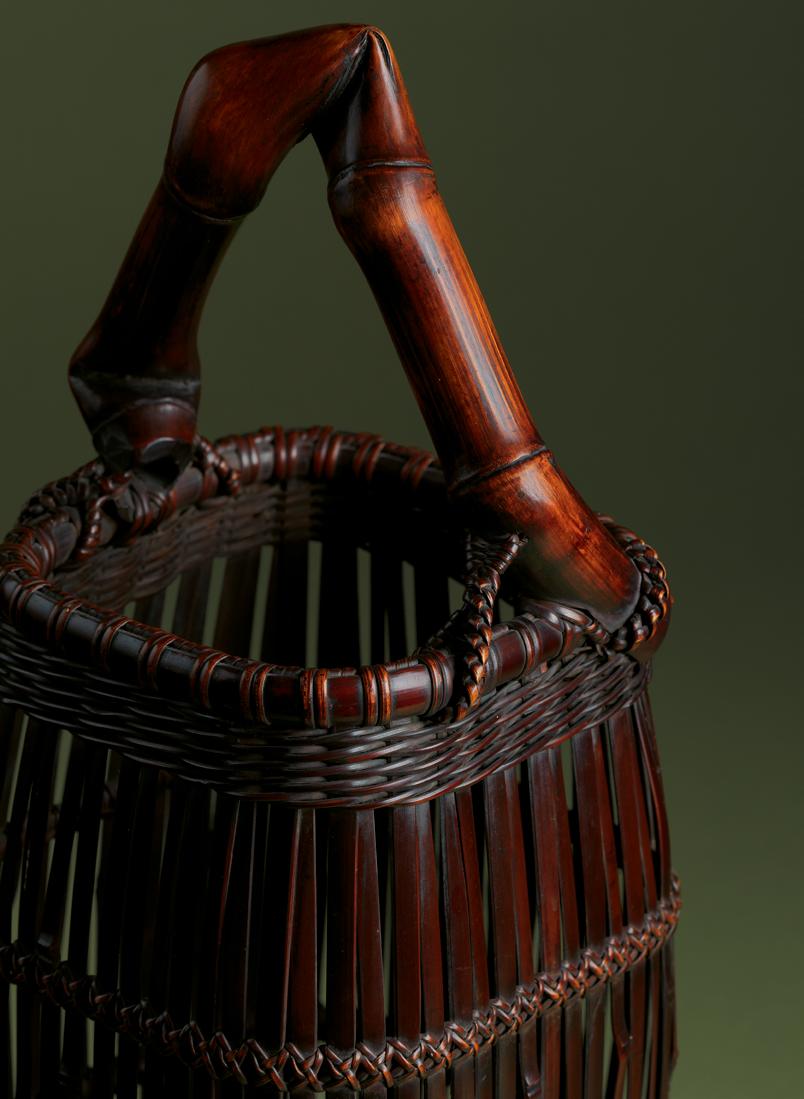
Signed: Chikuunsai made this
Susudake (smoked bamboo) and rattan; parallel-line construction, twining, knotting
Height: 45.4cm
Width: 16.0cm
Depth: 16.0cm
Box inscription: Susudake yoroi-tsuzuri hanakago (smoked bamboo flower basket bound in the style of a suit of armour); Sakaifu Nansō Chikuunsai kore o tsukuru (Chikuunsai of the Nansō Studio made this in Sakai); Seals: Denjō no in (seal of Denjō), Chikuunsai
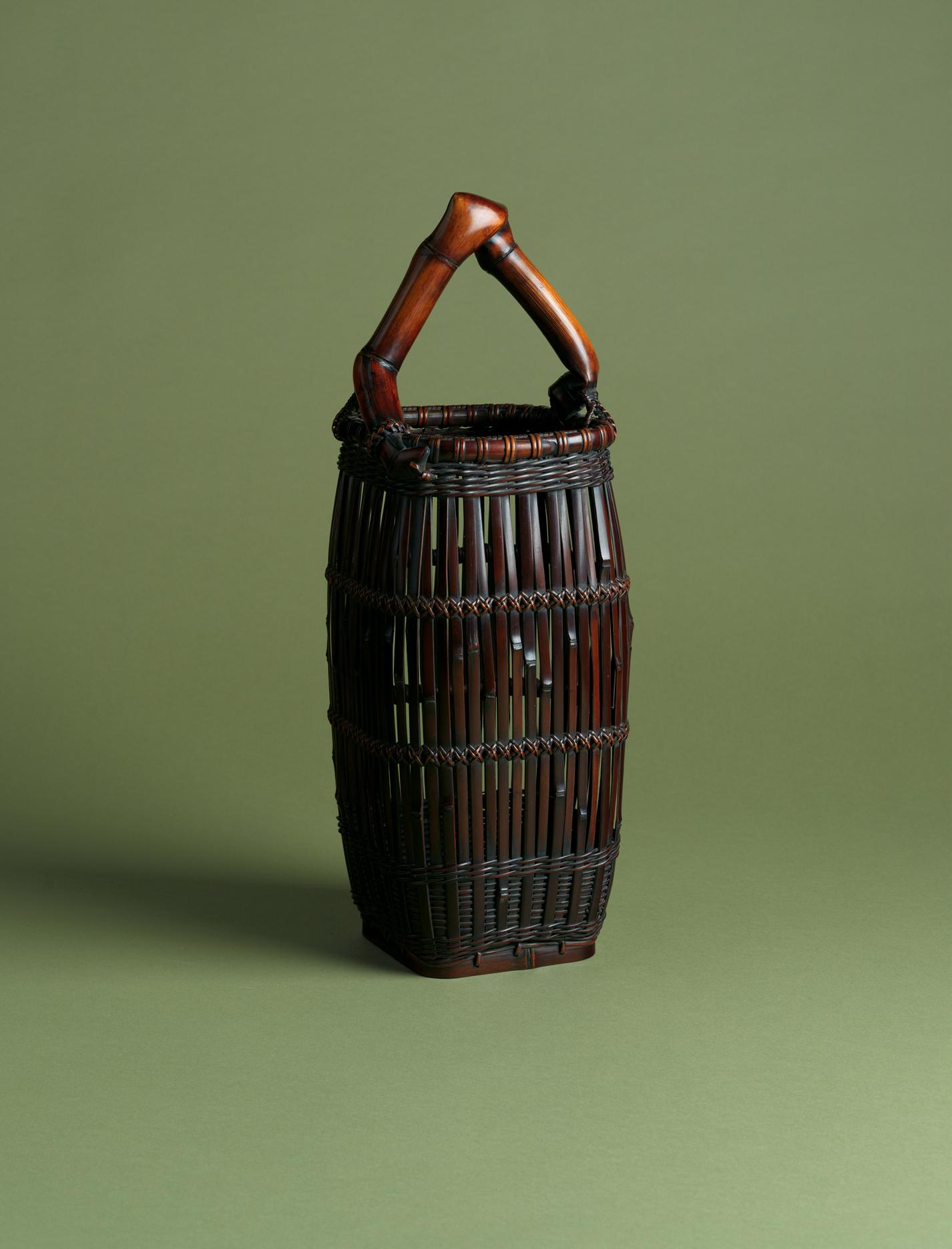
Maeda Chikubōsai (1872 - 1950)
Flower basket in the form of a gabion with bamboo-root handle, 1928
Signed: Chikubōsai made this Susudake (smoked bamboo) and rattan; compound lozenge plaiting, wrapping
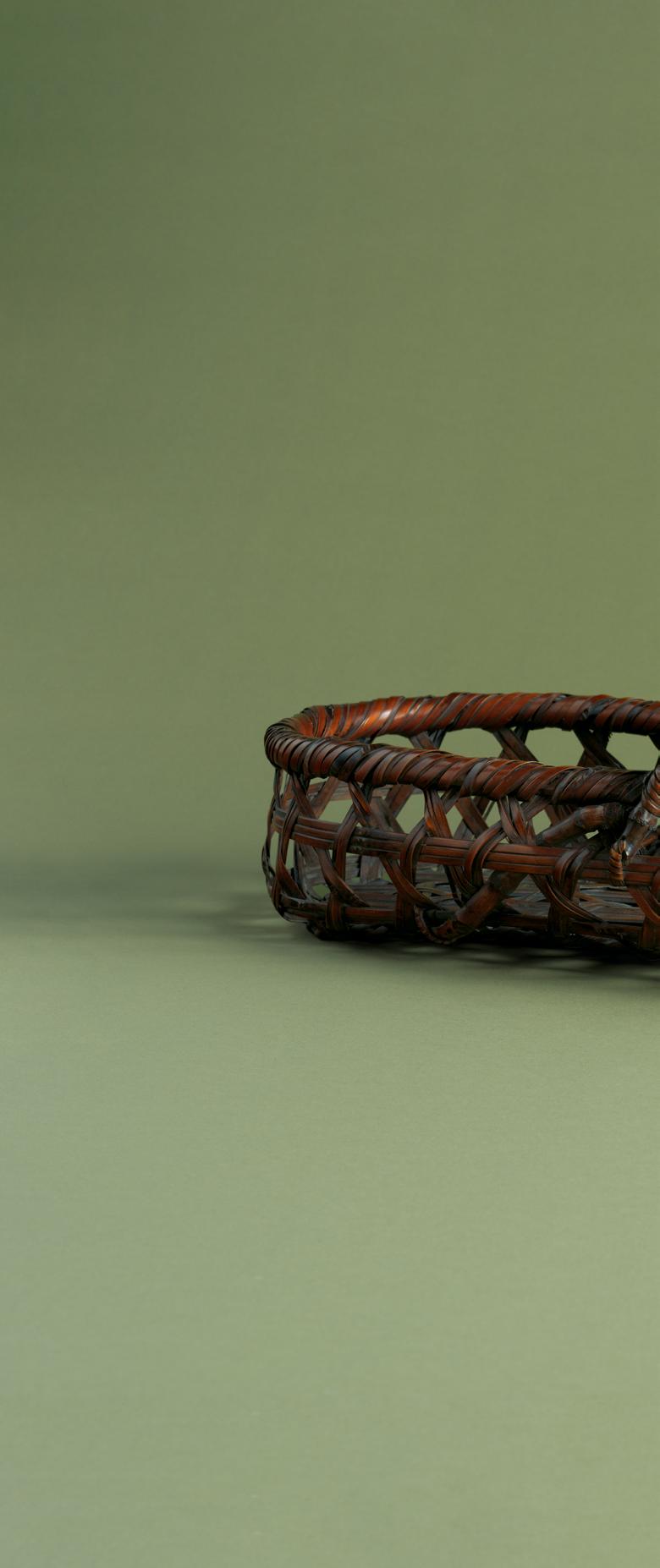
Height: 20.5cm
Width: 66.5cm
Depth: 24.5cm
Box inscription: Tennen chikkonte jakagogata hanakago (flower basket in the form of a gabion, with natural bamboo-root handle); Shōwa san bōshin shūjitsu Chikubōsai kore o tsukuru (Chikubōsai made this in the autumn of 1928);
Seal: Chikubōsai
A jakago (literally, ‘snake basket’) or gabion is a large basket filled with stones and used to reinforce riverbanks, particularly in and around Kyoto; jakago are seen in screens from the sixteenth century onwards, as well as in lacquer and other arts.
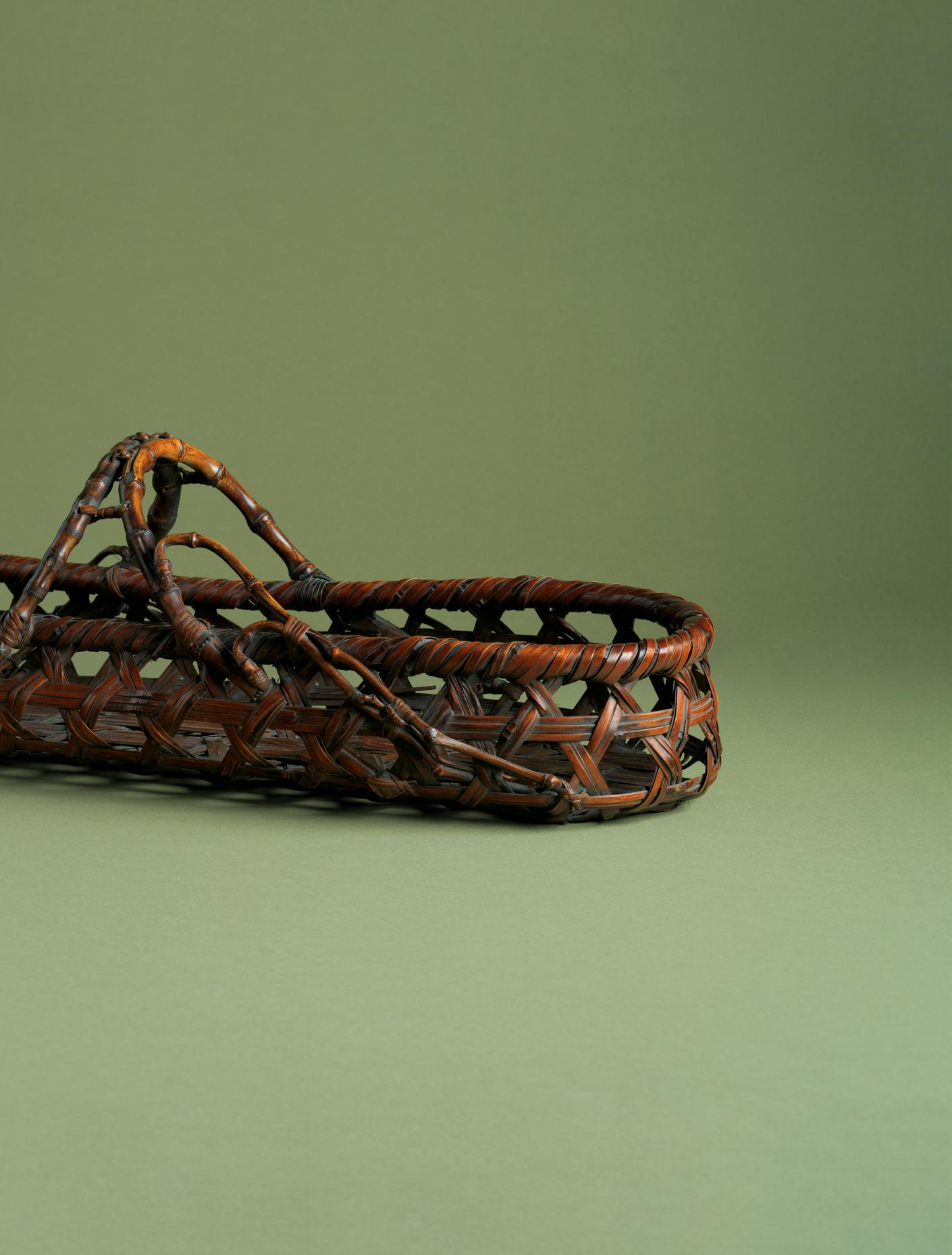
9
Wada Waichisai III (1899 - 1975)
Flower basket with handle

Signed: Made by Waichisai
Susudake (smoked bamboo); free-style plaiting, wrapping
Height: 46.0cm
Width: 31.5cm
Depth: 25.5cm
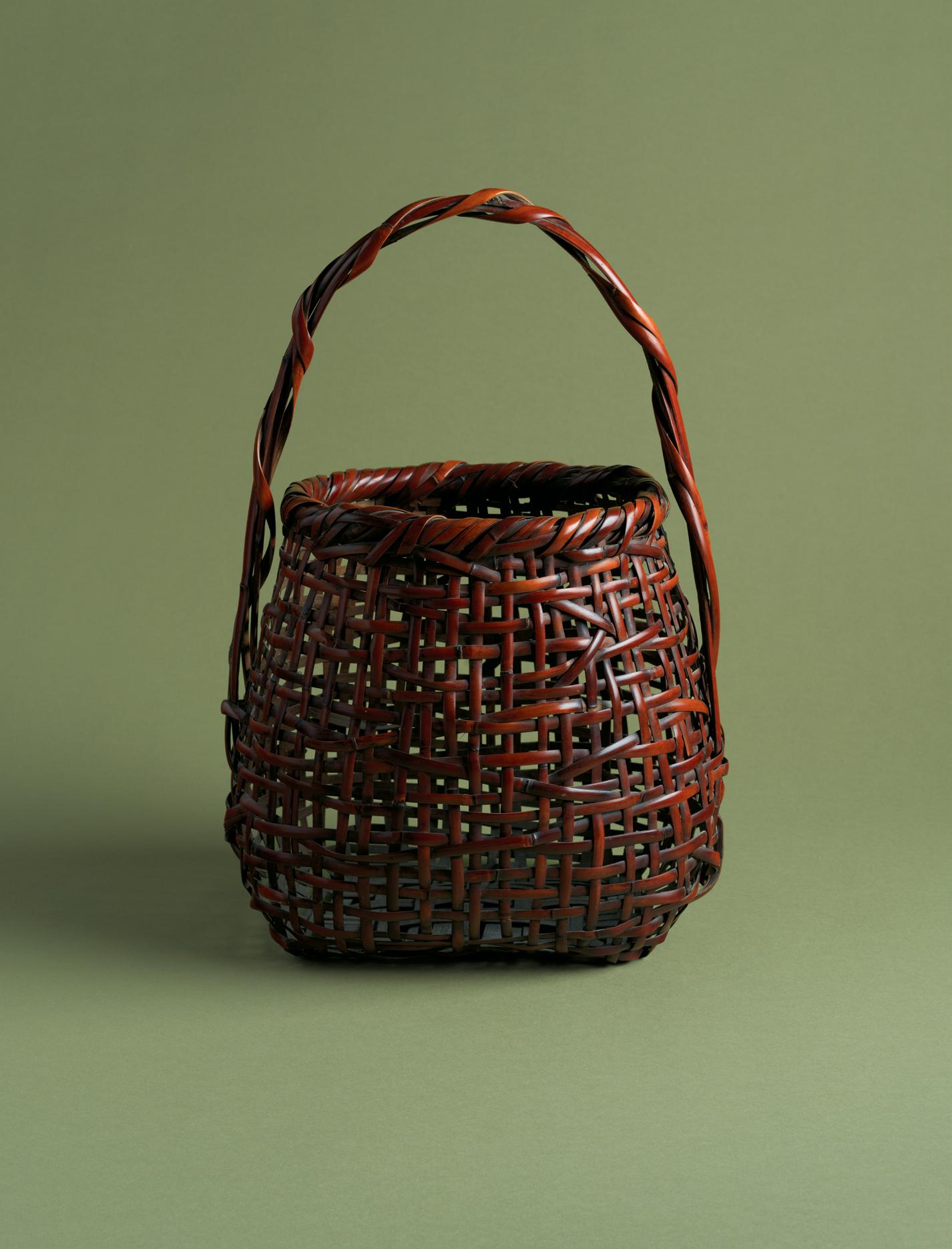
10
Honma Hideaki (b. 1959)
Zanzō Nami - 1 & 2 ( After Image - Wave 1 & 2 ) , 2022
Signed: Hide
Kurochiku bamboo and rattan; bending, knotting
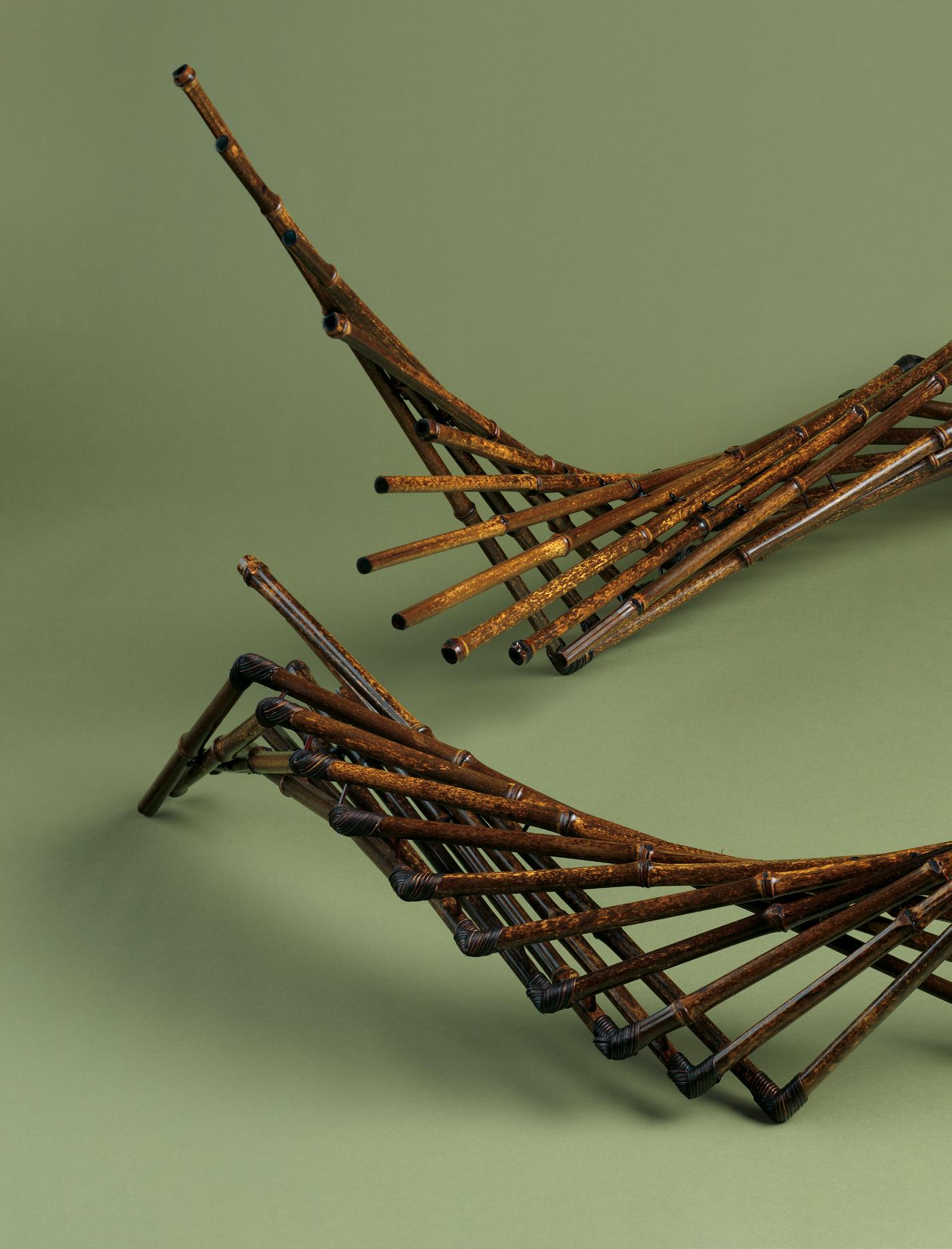
Height: 49.5 and 47.4cm
Width: 101.9 and 78.5cm
Depth: 23.5 and 19.0cm
Box inscription: 2022nen ; Zanzō 2 ( After Image 2 ); Hideaki ; Seal: Hideaki

11
Sugiura Noriyoshi (b. 1964)
Tamentai no obuje ( Polyhedron Objet ), 2018

Signed: Noriyoshi
Madake bamboo, rattan and lacquer
Height: 22.5cm
Width: 23.7cm
Depth: 23.7cm
Box inscription: Tamentai no obuje (Polyhedron Objet); Noriyoshi; Seal: Sugiura Noriyoshi
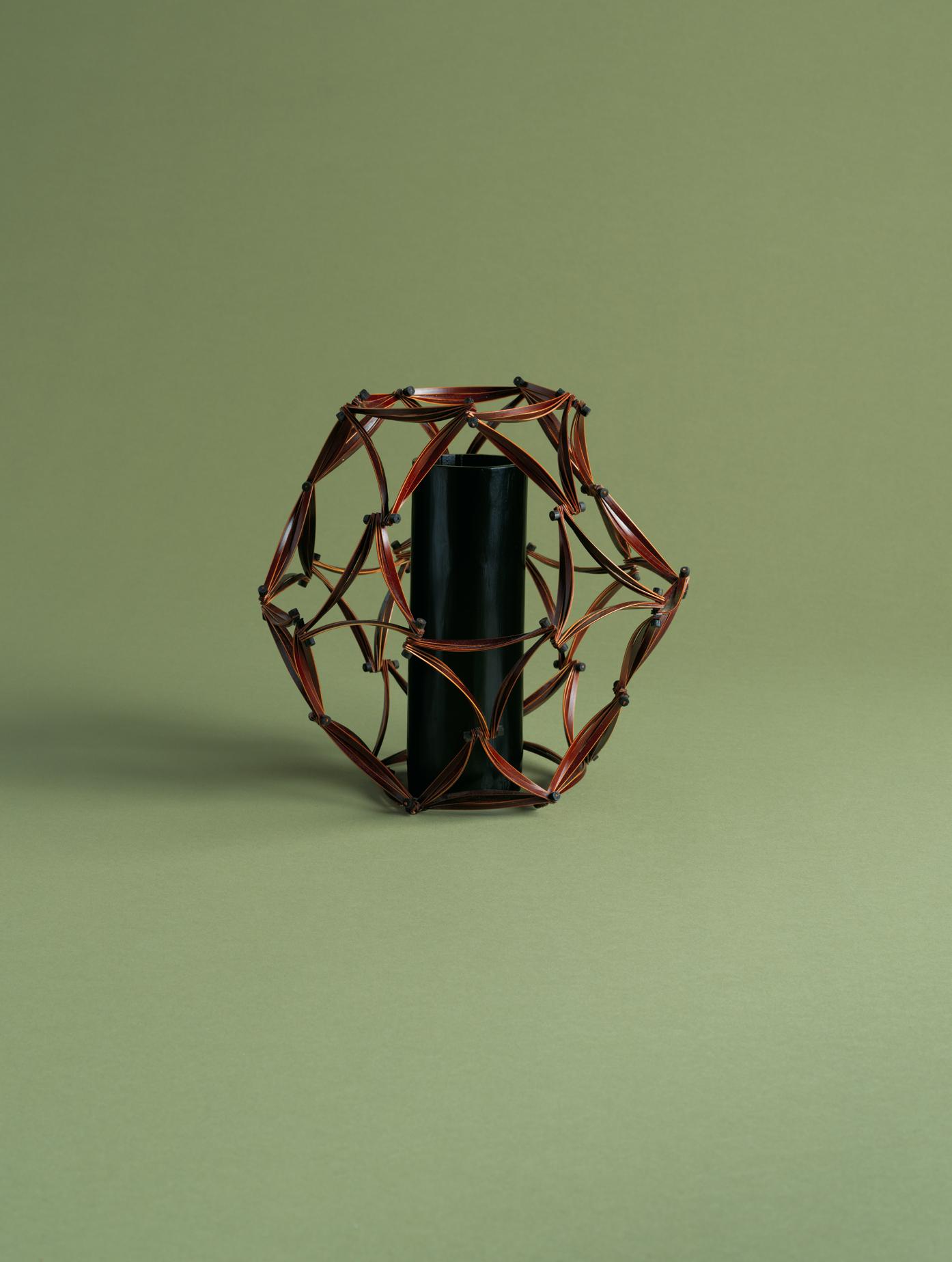
Tanabe Chikuunsai II (1910 - 2000)
Juzan ( Mountain of Longevity ) flower basket, ca. 1990
Signed: Made by Chikuunsai
Hōbichiku bamboo and lacquer; free-style hexagonal plaiting

Height: 14.0cm
Width: 31.5cm
Depth: 31.0cm
Box inscription: Juzan hanakago hōbichiku ( Mountain of Longevity flower basket [made from] hōbichiku [smoked dwarf bamboo]); Sanju Tekisuikyo Chikuunsai tsukuru (made by Tekisuikyo Chikuunsai, aged 80); Seals: Denri no in (seal of Denri), Chikuunsai

Tanabe Chikuunsai IV (b. 1973)
Juzan ( Mountain of Longevity ), 2018
Signed: Made by Chikuunsai
Madake bamboo, rattan, staining and lacquer; free-style plaiting, knotting, natural bambooroot handle

Height: 21.2cm
Width: 42.6cm
Depth: 42.6cm
Box inscription: Tennenchiku Juzan (natural bamboo, Mountain of Longevity ); Heisei sanjūnen yondai Chikuunsai (Chikuunsai IV, 2018); Seal: Chikuunsai
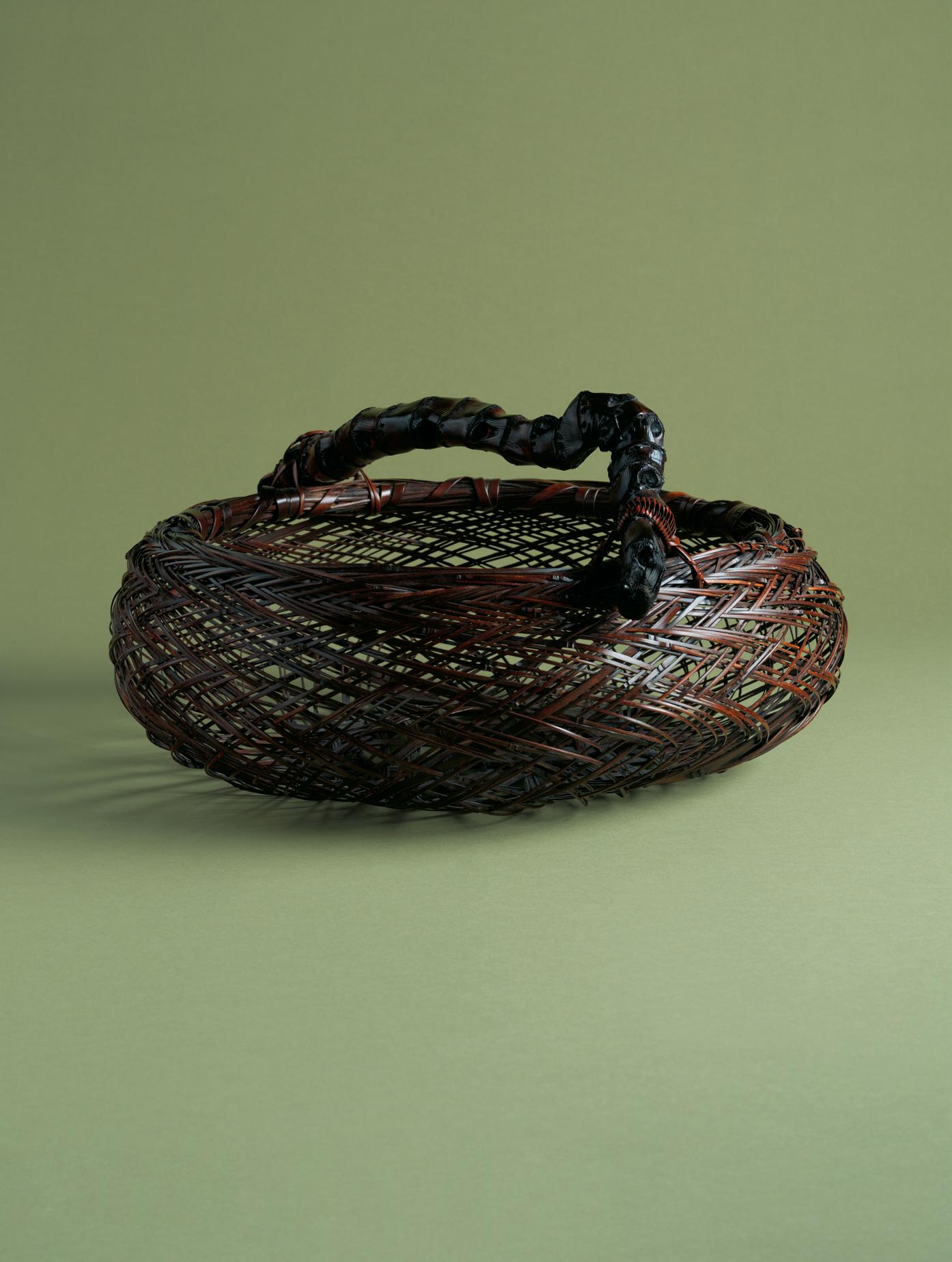
Fukunishi Ryōsei (b. 1941)
Kagayaki II ( Radiance II ) flower basket, ca. 2017
Signed: Ryōsei
Madake bamboo and rattan; parallel-line construction, asanoha (hexagonal) plaiting, carving, knotting

Height: 35.6cm
Width: 38.0cm
Depth: 23.5cm
Box inscription: Hanakago Kagayaki II (flower basket Radiance II ); Heisei nijūjkyūnen Dai Jūrokkai
Dentō Kōgei Mokuchiku Ten nyūsen sakuhin (work selected for the Sixteenth Traditional Wood and Bamboo Craft Exhibition, 2017)
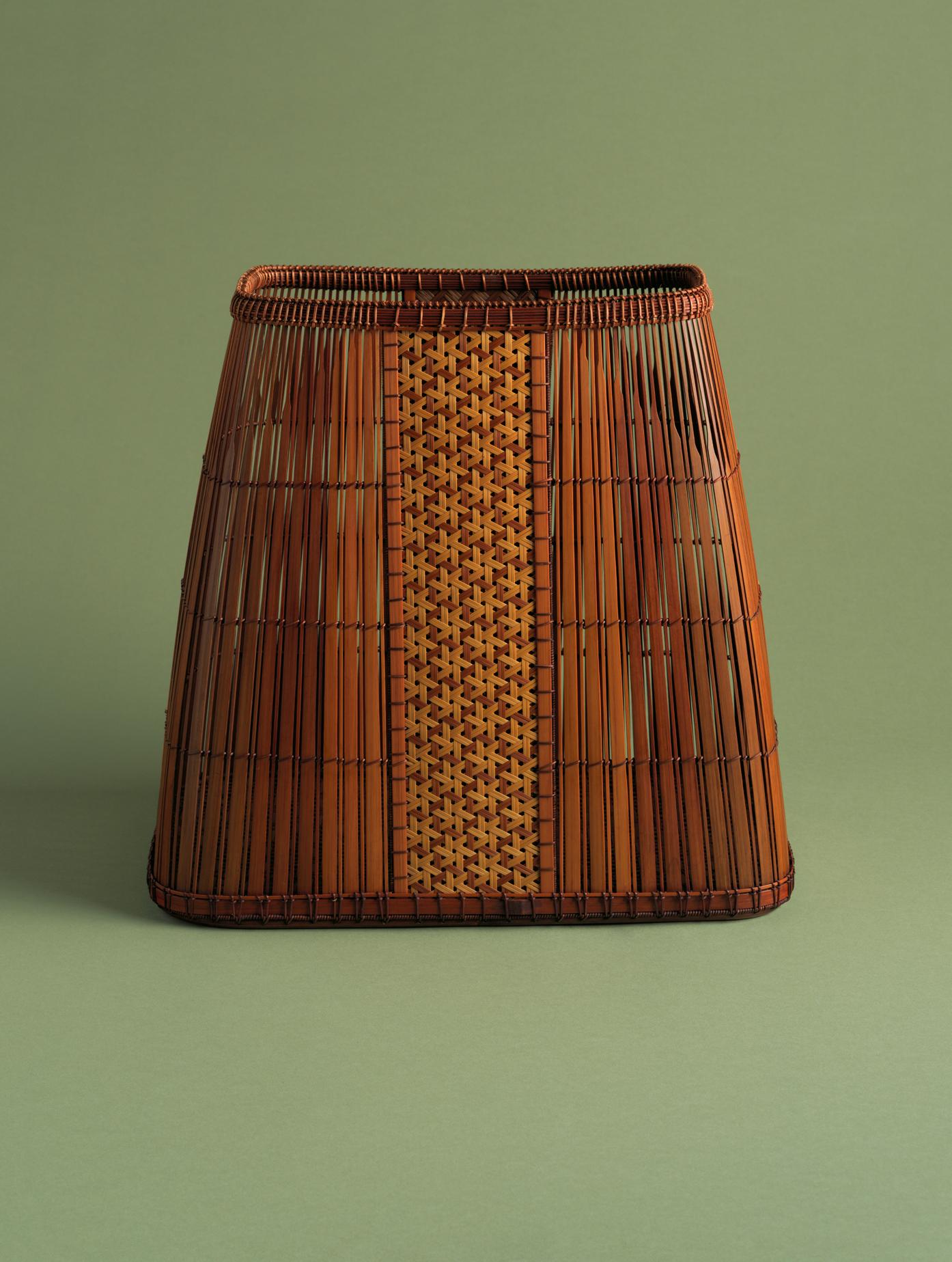
15
Mimura Chikuhō (b. 1973)
Hōun ( Cloud on the Peak ), 2018
Signed: Chikuhō
Madake bamboo and gilded lacquer; yatara-ami (free-style plaiting)
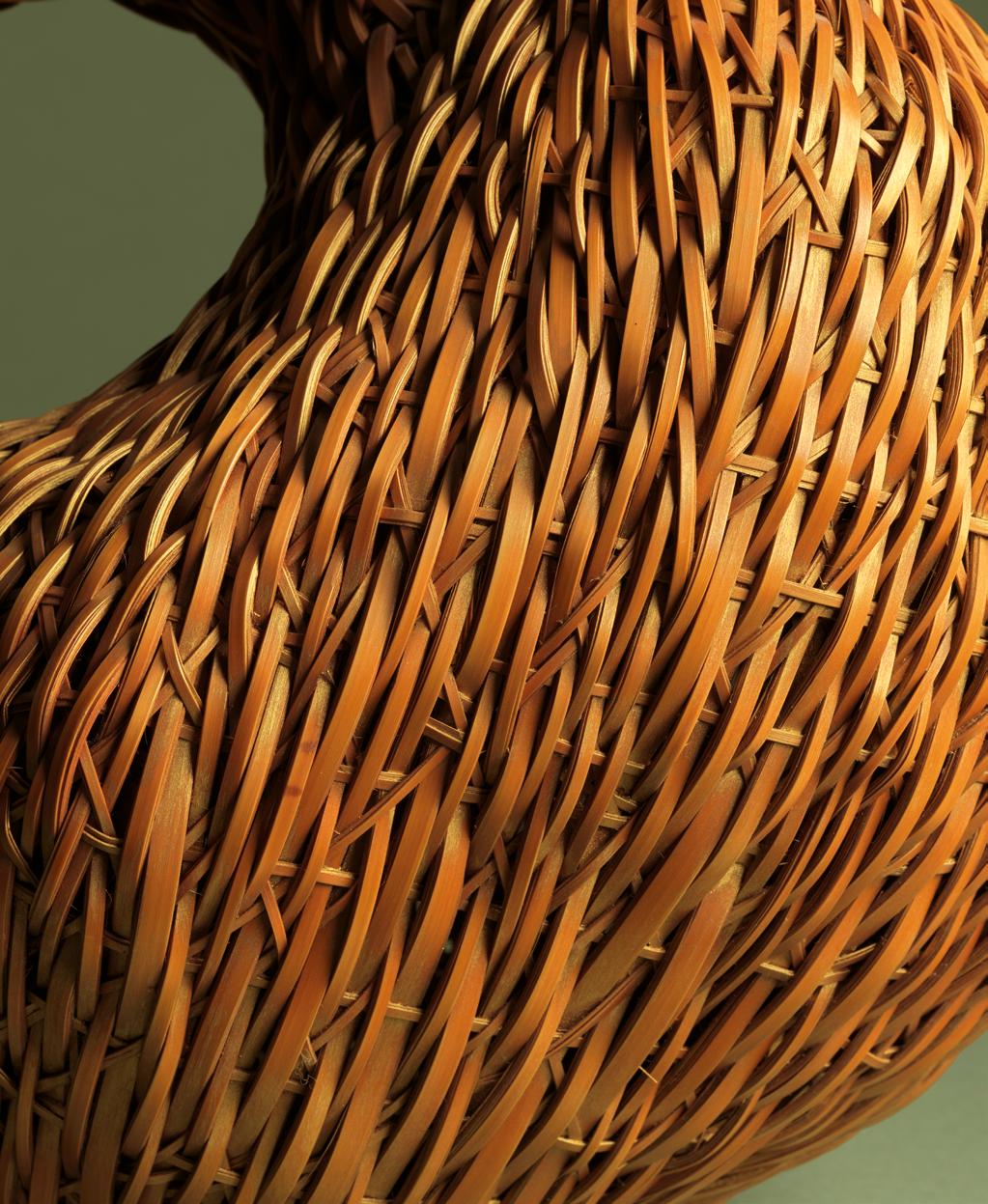
Height: 39.0cm
Width: 39.0cm
Depth: 31.5cm
Box inscription: Hōun ( Cloud on the Peak ); Chikuhō 2018 ; Seal: Chikuhō

Signed: Shōryū
Madake bamboo, rattan and lacquer; twill plaiting, bending
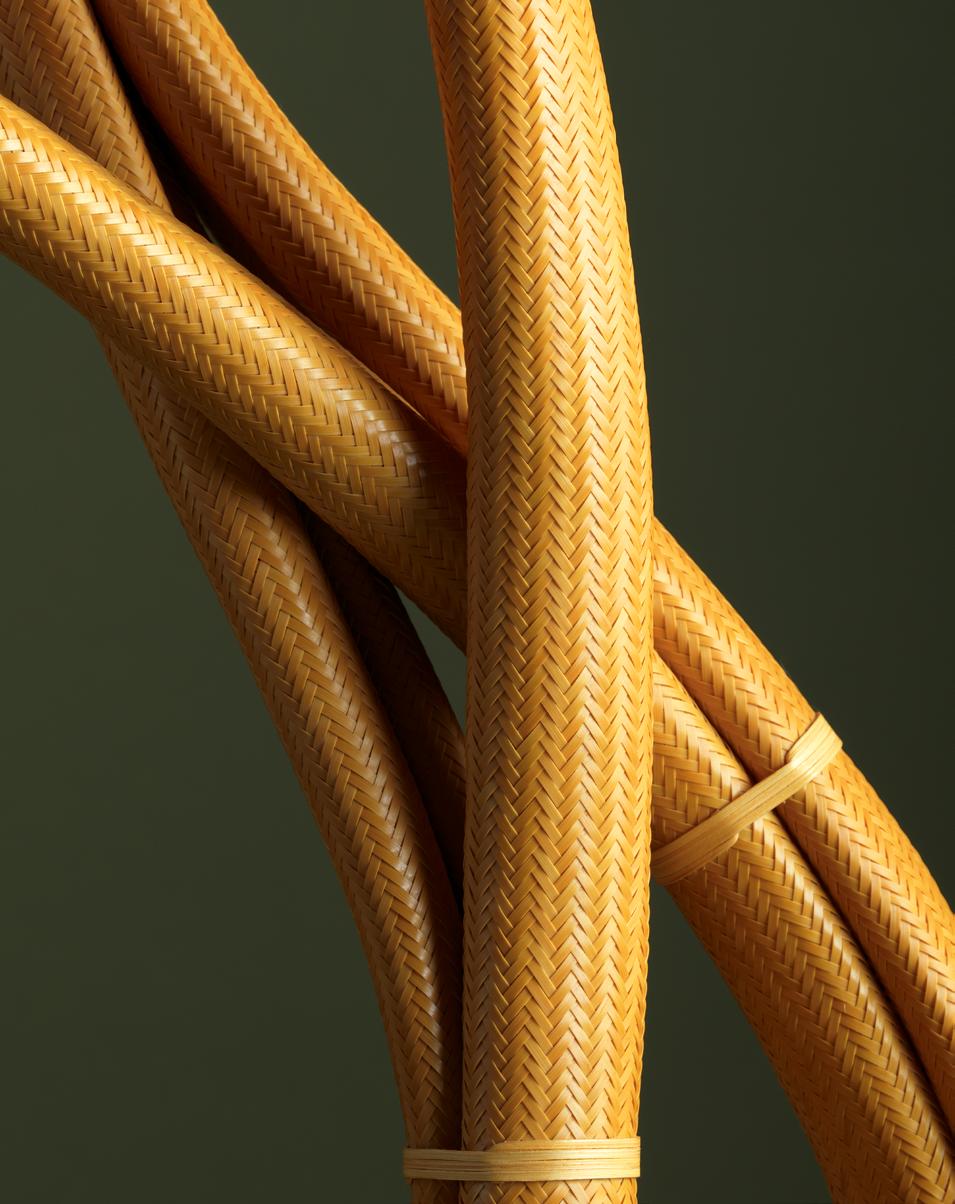
Height: 86.0cm
Width: 42.0cm
Depth: 23.0cm
Box inscription: Enbukyoku ( Waltz ); Shōryū ; Seal: Shōryū
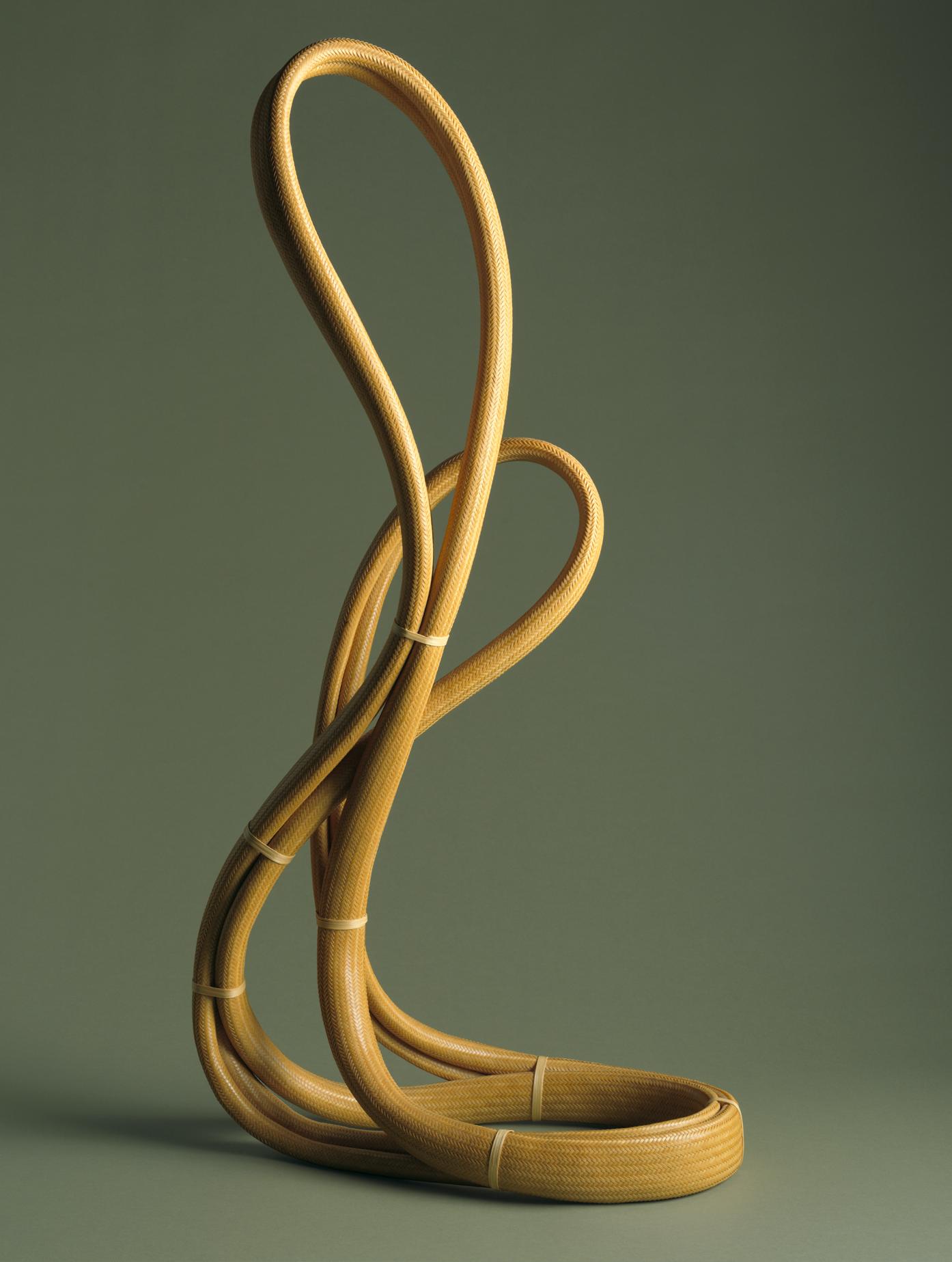
Shiotsuki Juran (1948 - 2016)
Yatara-ami obuje ( Objet in Free-Style Plaiting ), 1996

Signed: Juran 96
Madake bamboo, rattan and lacquer; yataraami (free-style plaiting)
Height: 56.0cm
Width: 73.5cm
Depth: 46.0cm
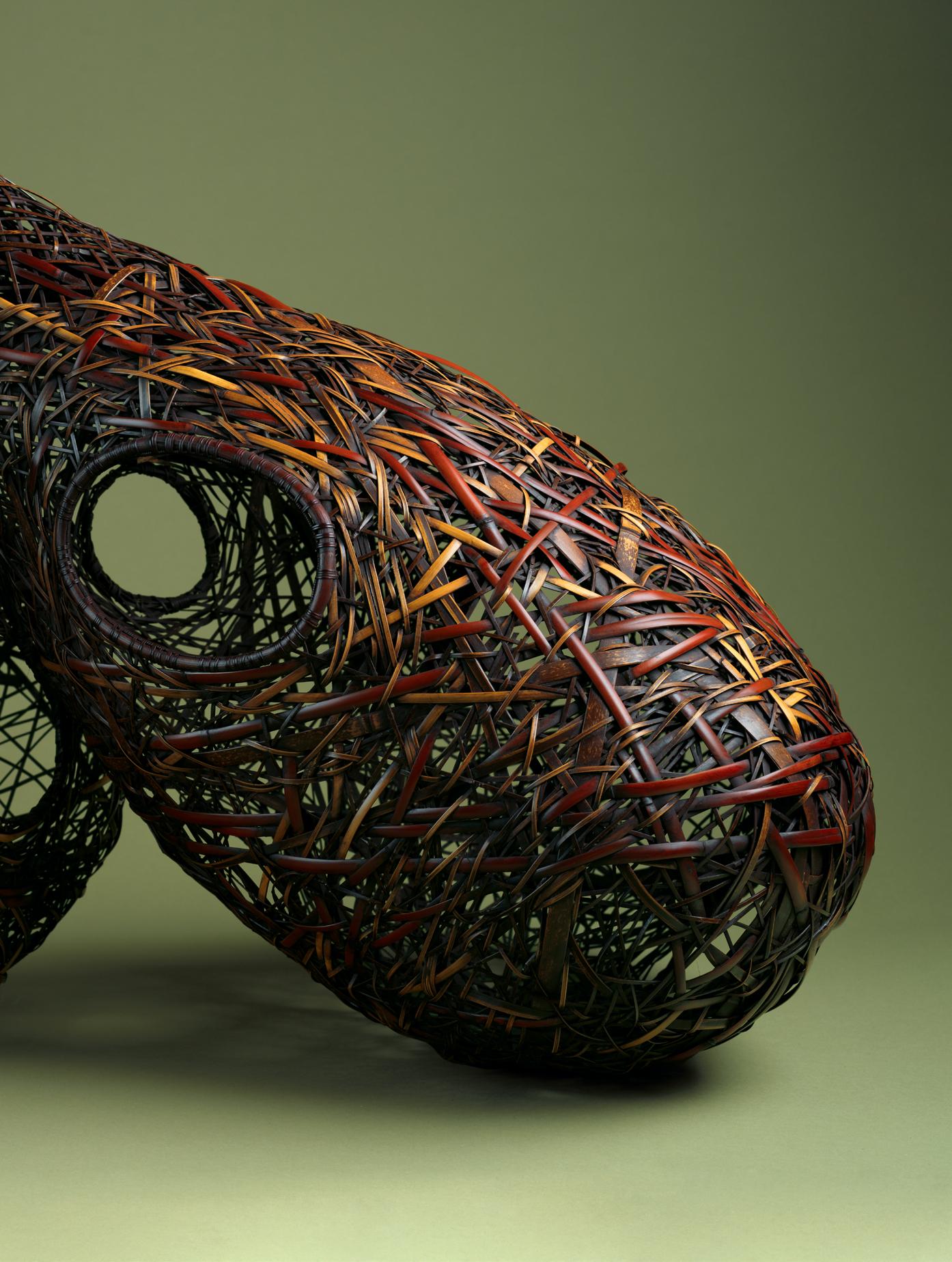
Uzunari ( Sound of the Whirlpool ), 2018
Signed: Noriyoshi
Madake bamboo, rattan and lacquer; modified parallel-line construction, knotting
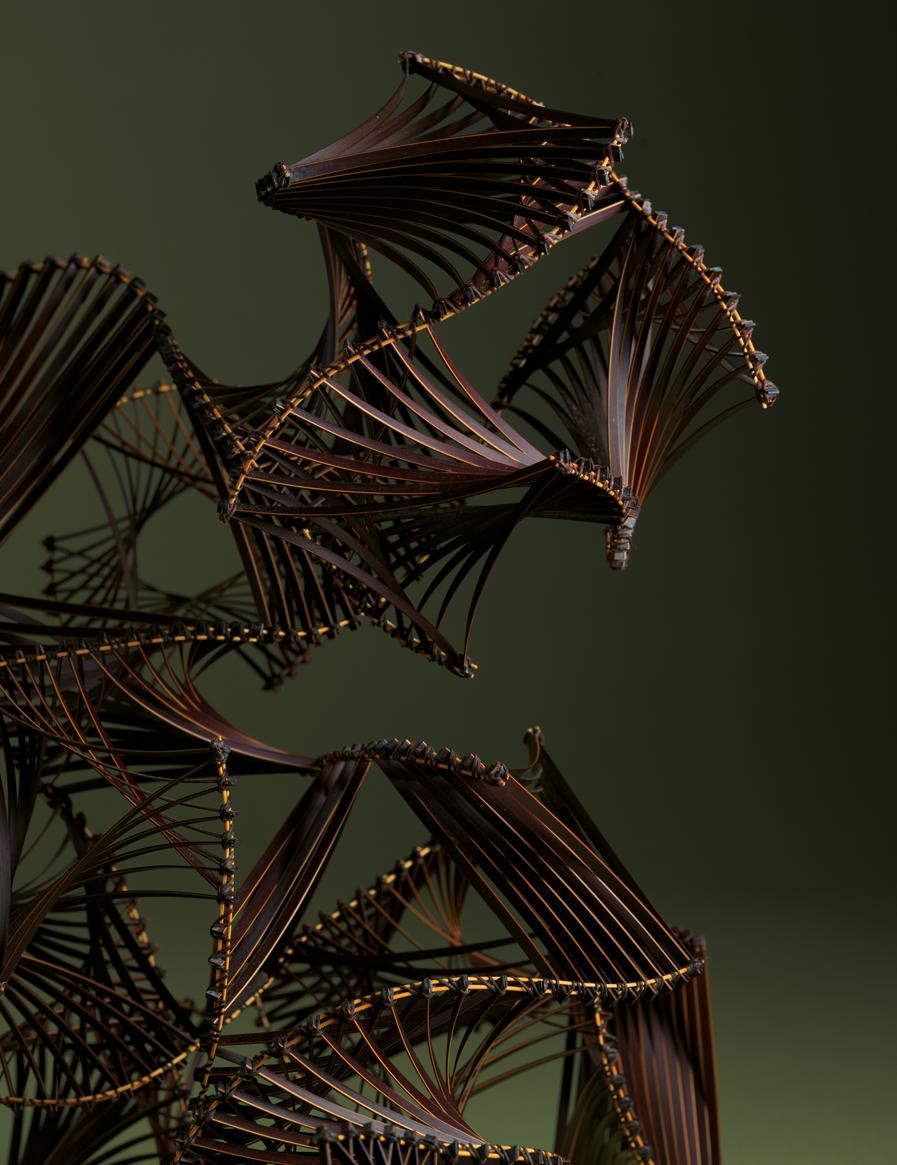
Height: 50.5cm
Width: 45.0cm
Depth: 40.0cm
Box inscription: Uzunari , ( Sound of the Whirlpool ); Noriyoshi ; Seal: Sugiura Noriyoshi

Sugiura Noriyoshi (b. 1964)
Sugomori ( Nesting )
Madake bamboo; free-style plaiting

Height: 18.5cm
Width: 38.5cm
Depth: 28.0cm
Box inscription: Sugomori ( Nesting ); Noriyoshi kore o tsukuru (Noriyoshi made this); Seal: Sugiura Noriyoshi
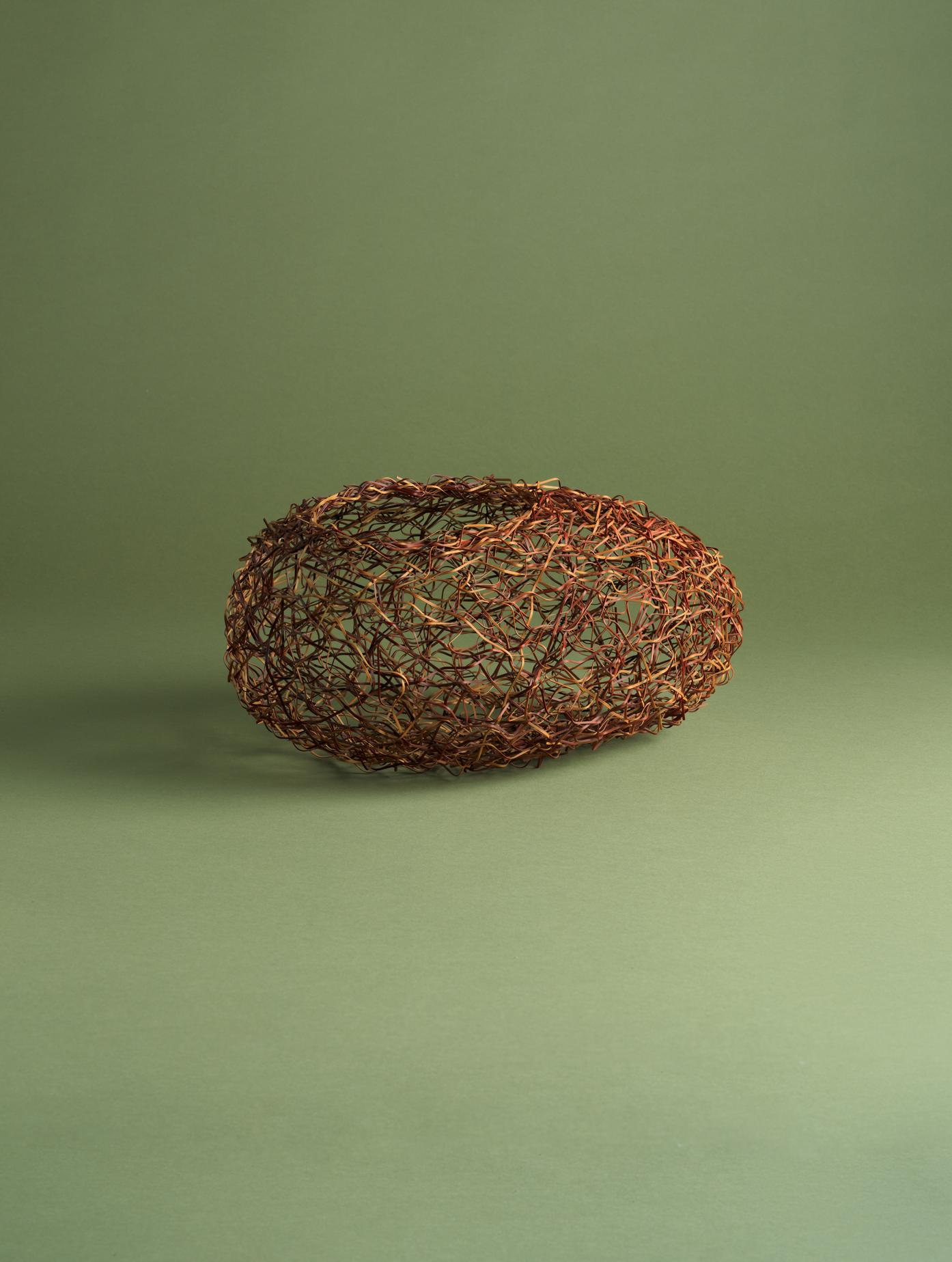
20
Honma Hideaki (b. 1959)
Sōryū ( Twin Currents ), 2022
Signed: Made by Hideaki
Madake and nemagaridake bamboo, rattan and lacquer; twill weaving and bending
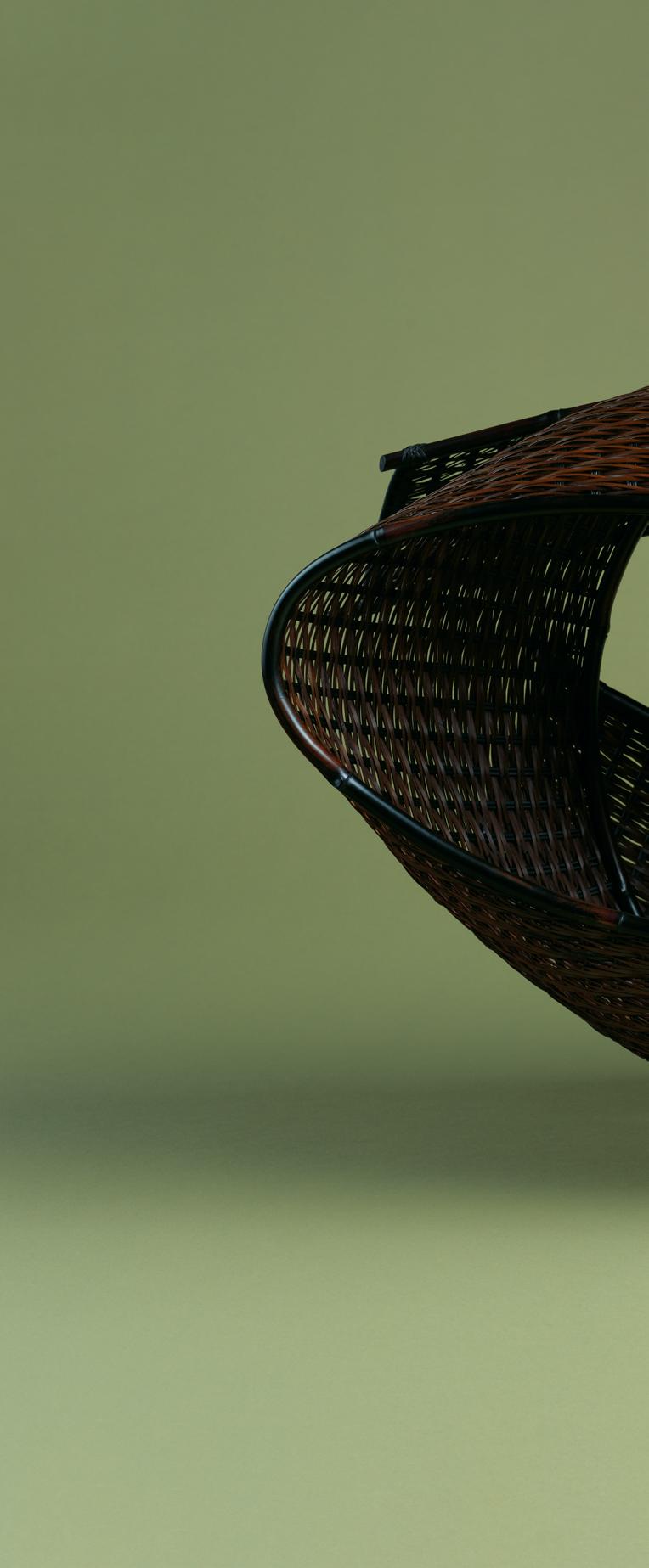
Height: 42.0cm
Width: 67.2cm
Depth: 25.5cm
Box inscription: 2022nen ; Sōryū ( Twin Currents ); Seal: Hideaki

Yufu Shōhaku (b. 1941)
Ranmaru ( The Warrior Mori Ranmaru ) flower basket, 2022
Signed: Shōhaku
Madake and kinmeichiku bamboo, rattan and staining; bundled and free-style plaiting
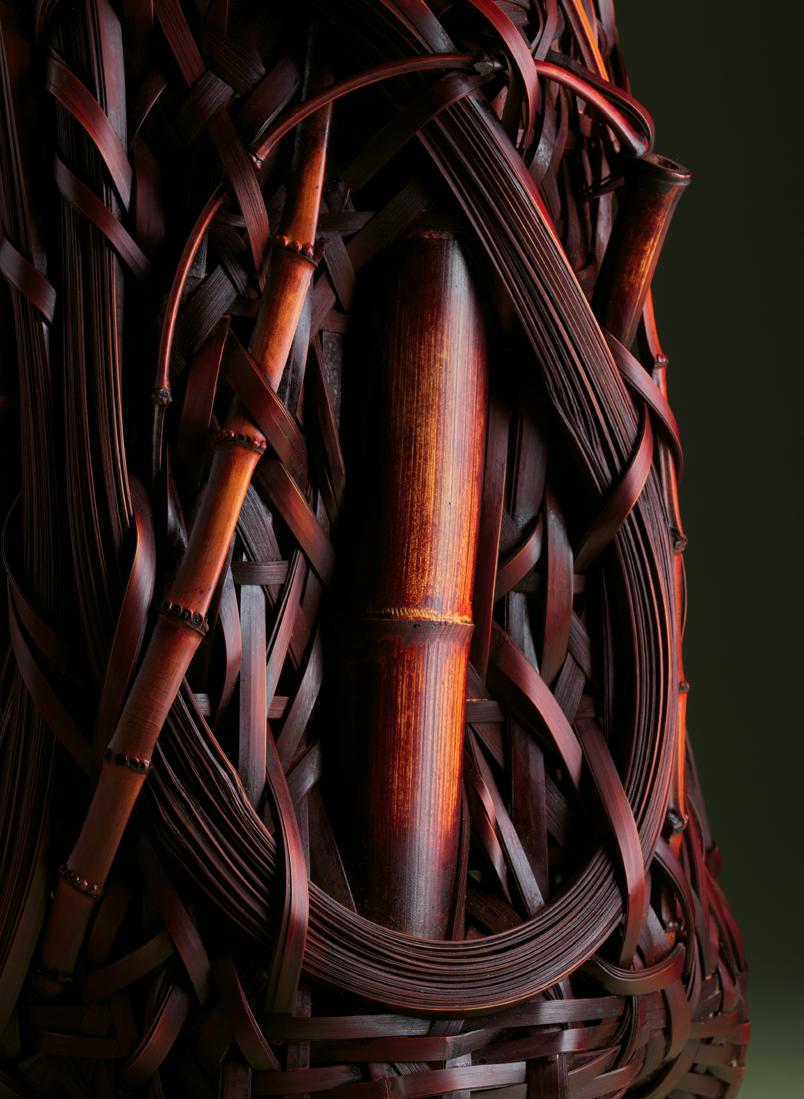
Height: 66.0cm
Width: 32.0cm
Depth: 35.0cm
Box inscription: Ranmaru ( The Warrior Mori Ranmaru ); Reiwa yonen Yufu Shōhaku saku (made by Yufu Shōhaku in 2022)
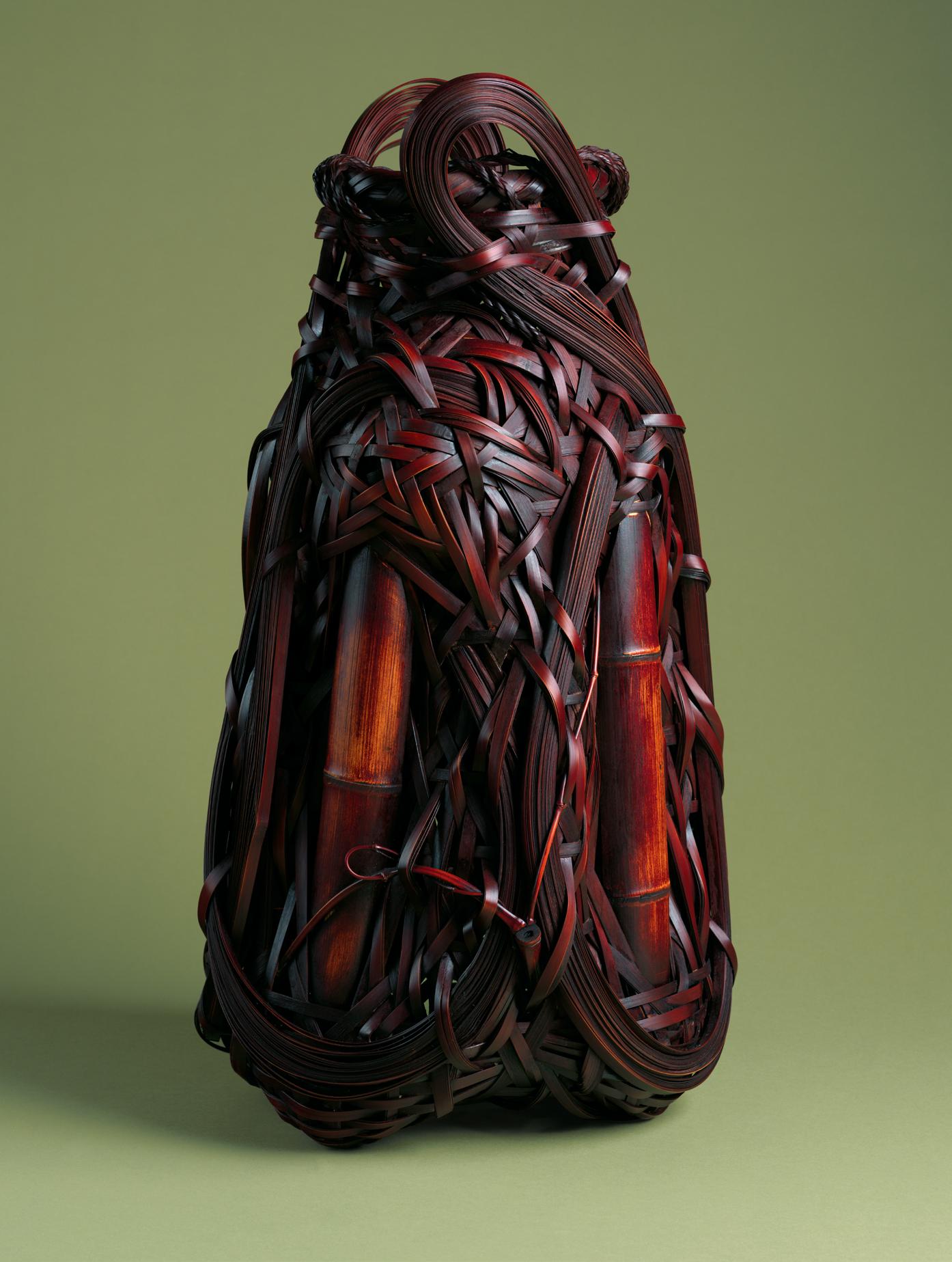
Yufu Shōhaku (b. 1941)
Fudō ( Guardian Deity ) flower basket, 2022
Signed: Shōhaku
Madake and kinmeichiku bamboo, rattan and staining; bundled and free-style plaiting
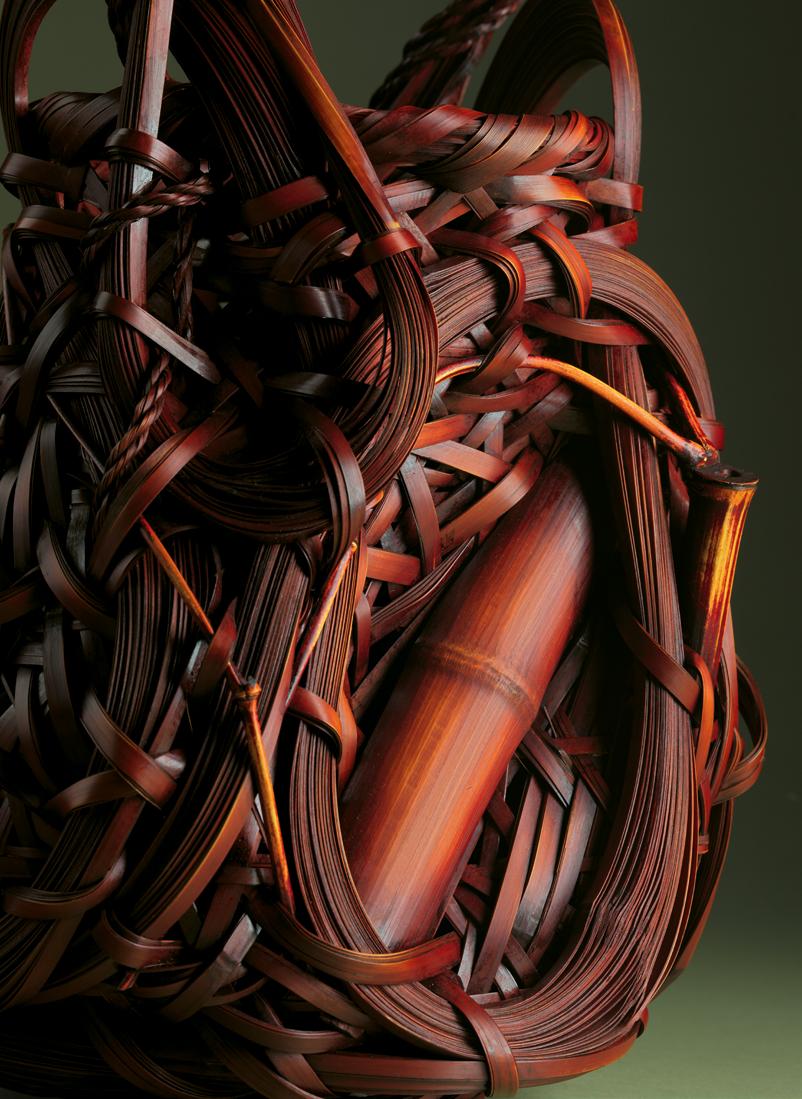
Height: 64.0cm
Width: 33.0cm
Depth: 32.4cm
Box inscription: Fudō ( Guardian Deity ); Reiwa yonen Yufu Shōhaku saku (made by Yufu Shōhaku in 2022); Seal: Shōhaku no in (seal of Shōhaku)
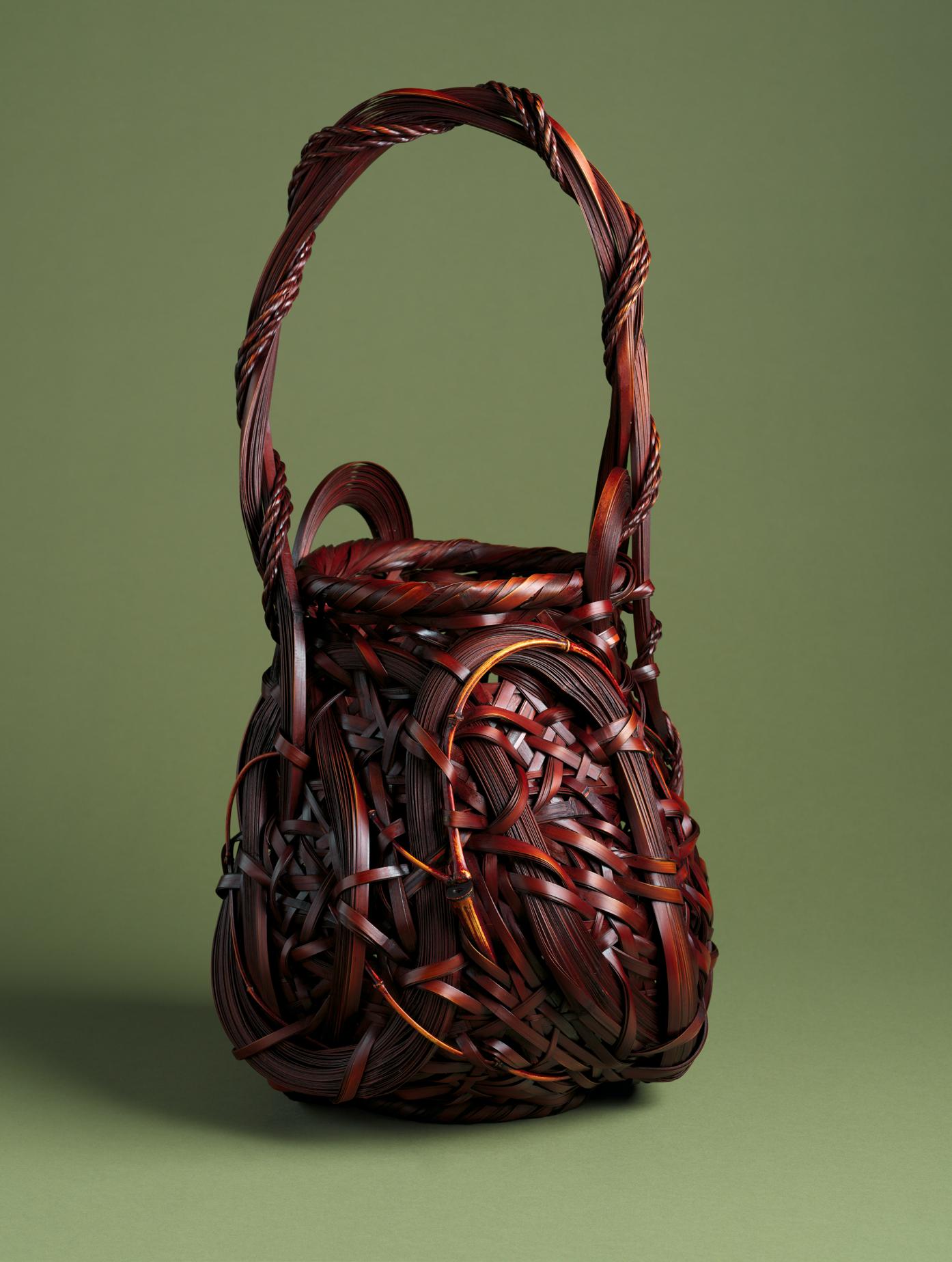
Sugiura Noriyoshi (b. 1964)
Mino ( Straw Raincoat ) flower basket, 2012
Signed: Noriyoshi
Nemagaridake bamboo, rattan, staining and lacquer; parallel-line construction, knotting
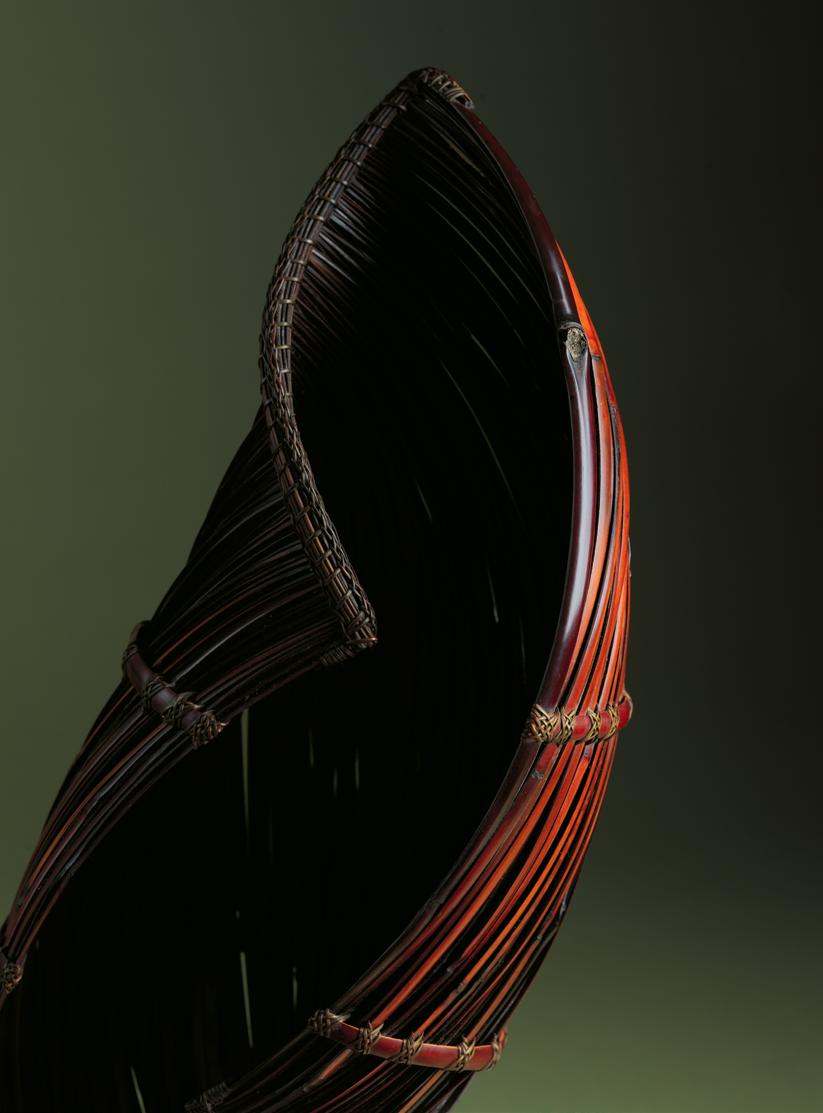
Height: 16.5cm
Width: 55.5cm
Depth: 18.5cm
Box inscription: Hanakago Mino (flower basket, Straw Raincoat ); Noriyoshi kore o tsukuru (Noriyoshi made this); Seal: Sugiura Noriyoshi

Signed: Noriyoshi
Madake bamboo, rattan and staining; parallel-line construction, twill plaiting, knotting
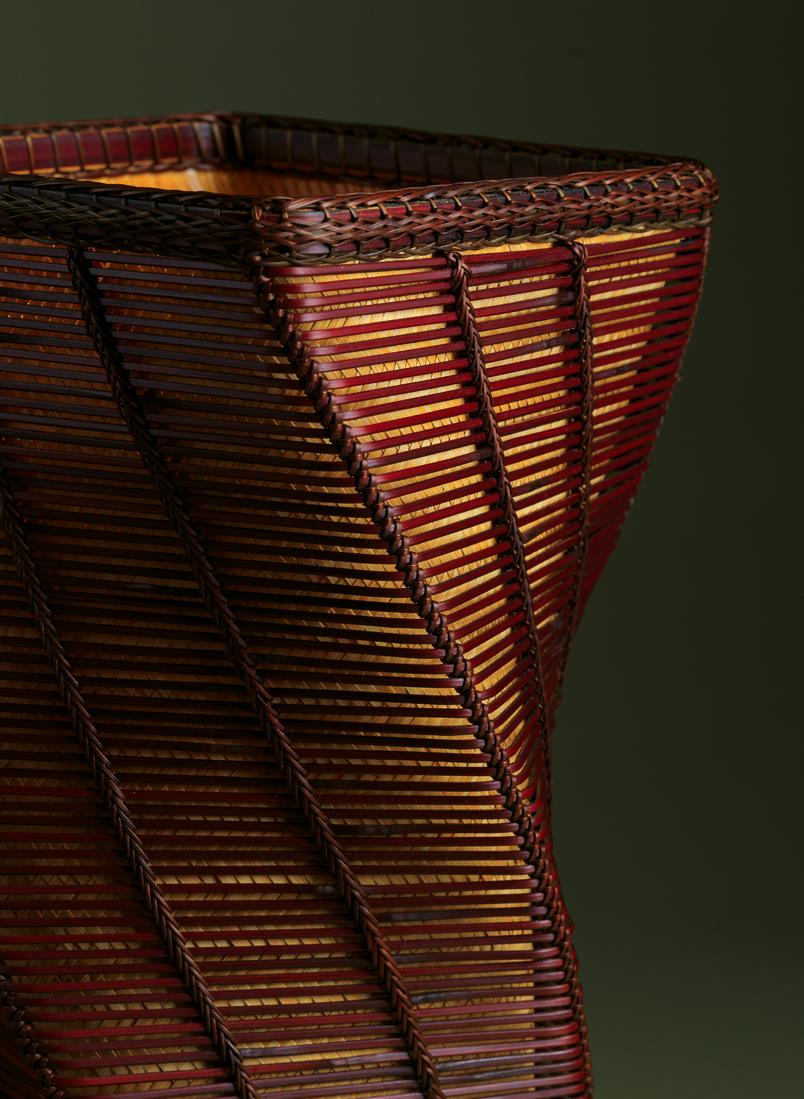
Height: 34.2cm
Width: 17.5cm
Depth: 17.5cm
Box inscription: Hanakago Sō (flower basket, Creation ); Noriyoshi ; Seal: Sugiura Noriyoshi

25
Shōno Tokuzō (b. 1942)
Shioma ( Ebb Tide ), 1985
Madake bamboo, rattan and steel wire; thousand-line construction; patterned twill plaiting

Height: 17.5cm
Width: 46.5cm
Depth: 41.5cm
Box inscription: Take no utsuwa (bamboo container); Mei Shioma Tokuzō saku (named Ebb Tide , made by Tokuzō); Seal: Tokuzō no in (seal of Tokuzō)
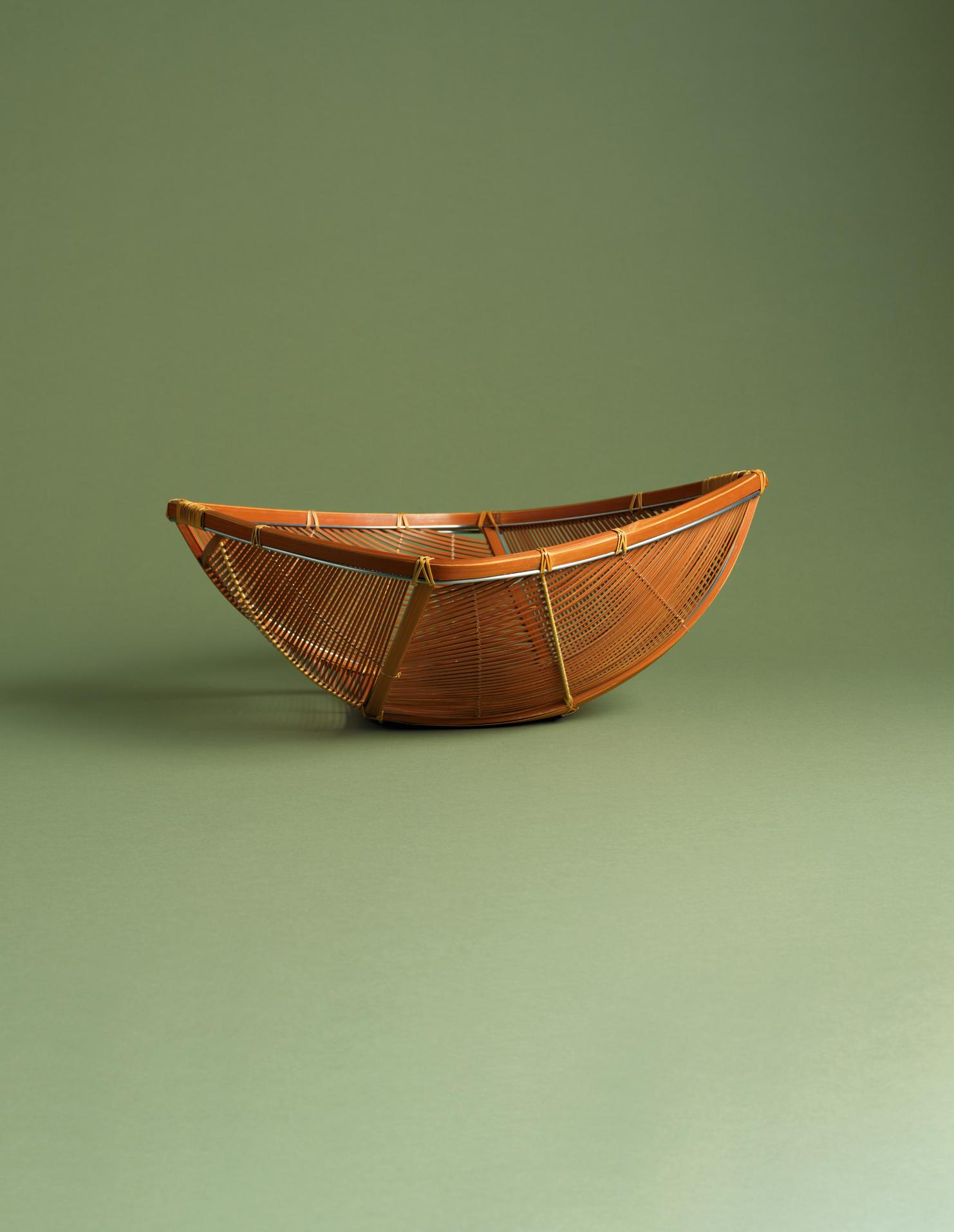
Signed: Tokuzō made this Madake bamboo and rattan; bundled plaiting, knotting

Height: 34.5cm
Width: 36.0cm
Depth: 35.0cm
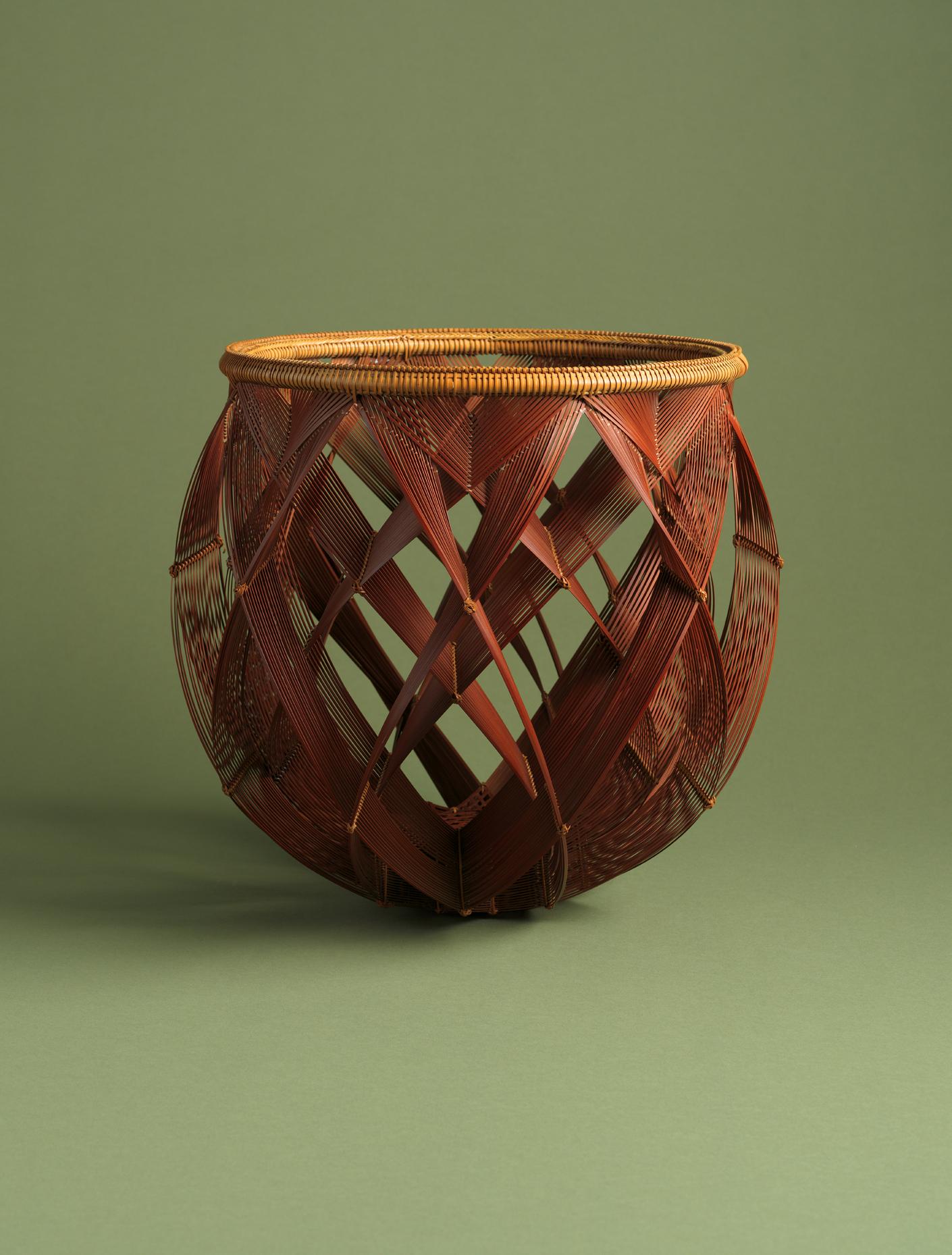
Honma Hideaki (b. 1959)
Tensō ( Shifting Impression s), 2009
Signed: Hideaki
Madake bamboo and rattan; twill plaiting,
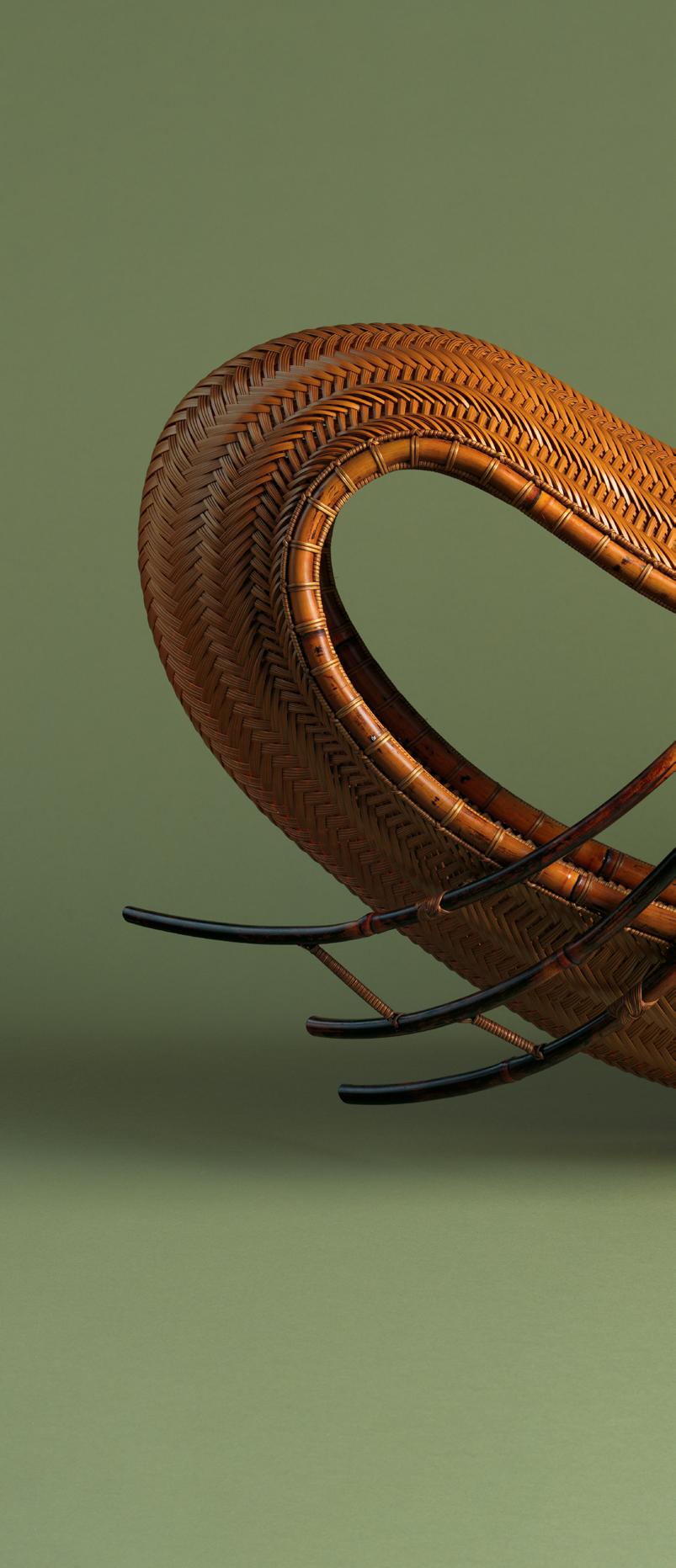
bending
Height: 43.0cm
Width: 76.2cm
Depth: 28.0cm
Box inscription: 2009nen ; Tensō ( Shifting Impressions ); Hideaki
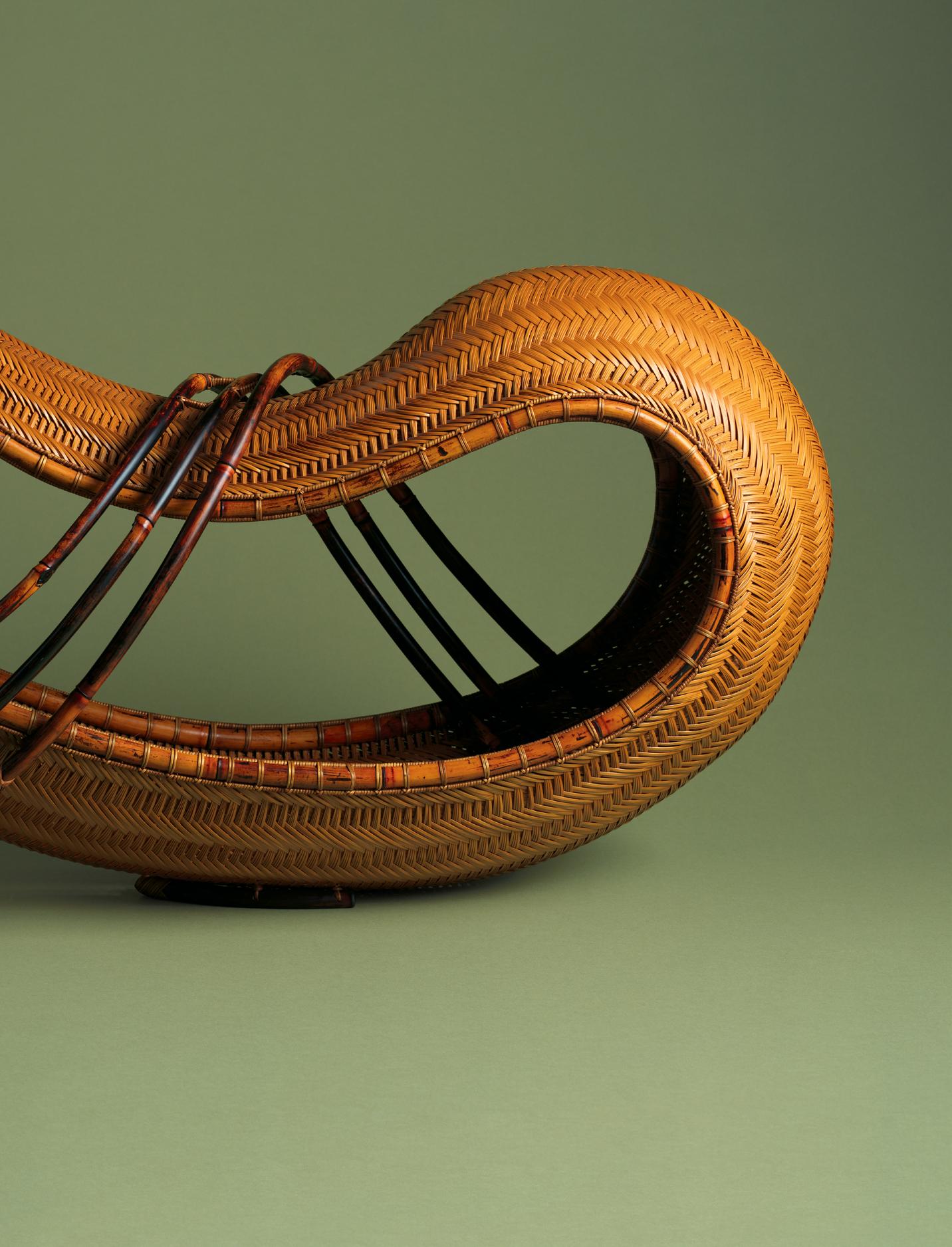
Iizuka Shōkansai (1919 - 2004)
Ryōfū ( Cool Breeze ) hanging flower basket
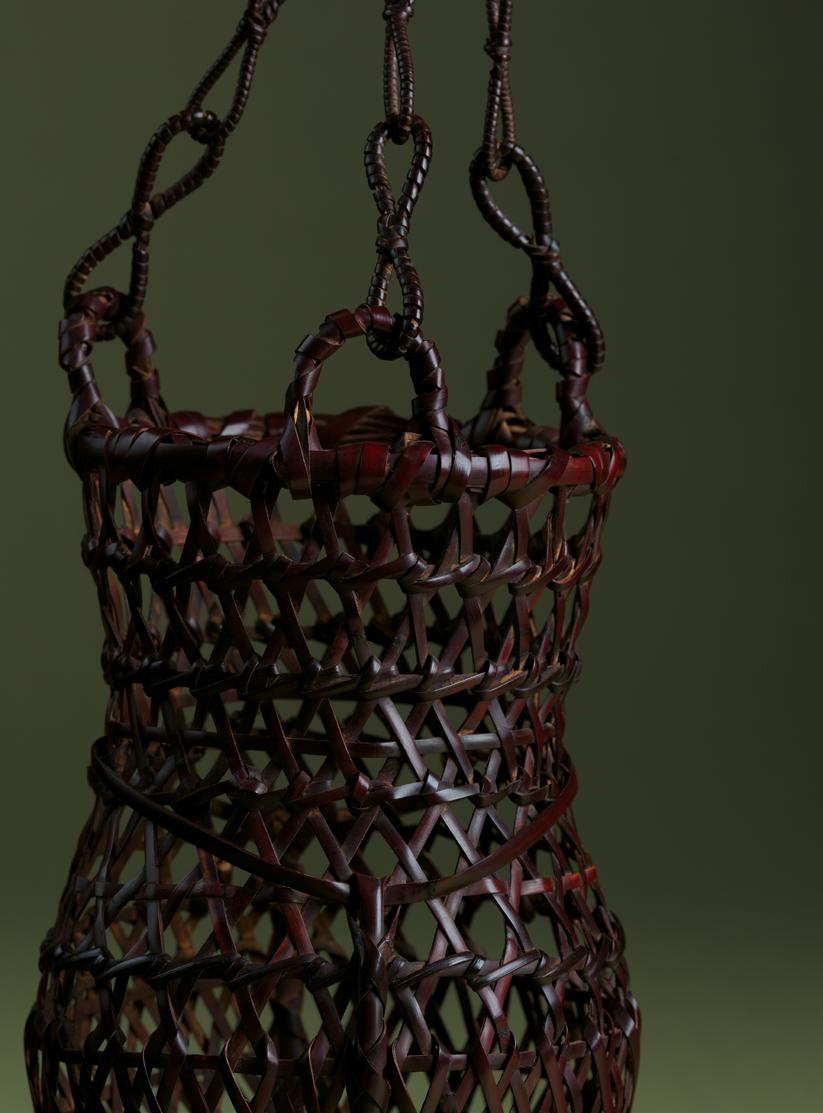
Signed: Made by Shōkansai
Hōbichiku bamboo, rattan and lacquer; hexagonal plaiting, knotting
Height: 27.0cm (50.0cm)
Width: 16.5cm
Depth 16.0cm
Box inscription: Hōbichiku hisagogata tsurihanakago ( Hōbichiku gourd-shaped hanging flower basket); Ryōfū ( Cool Breeze ); Shōkansai saku (made by Shōkansai); Seal: Shōkansai

Signed: Tōkōsai made this
Bamboo and rattan; hexagonal plaiting, twining, knotting
Height: 18.5cm (63.0cm)
Width: 24.6cm
Depth: 24.6cm
Box inscription: Karamono utsushi marugata tsurihanakago (round hanging flower basket in Chinese style); Tōkōsai kore o tsukuru (Tōkōsai made this); Seal: Tōkōsai saku (made by Tōkōsai)
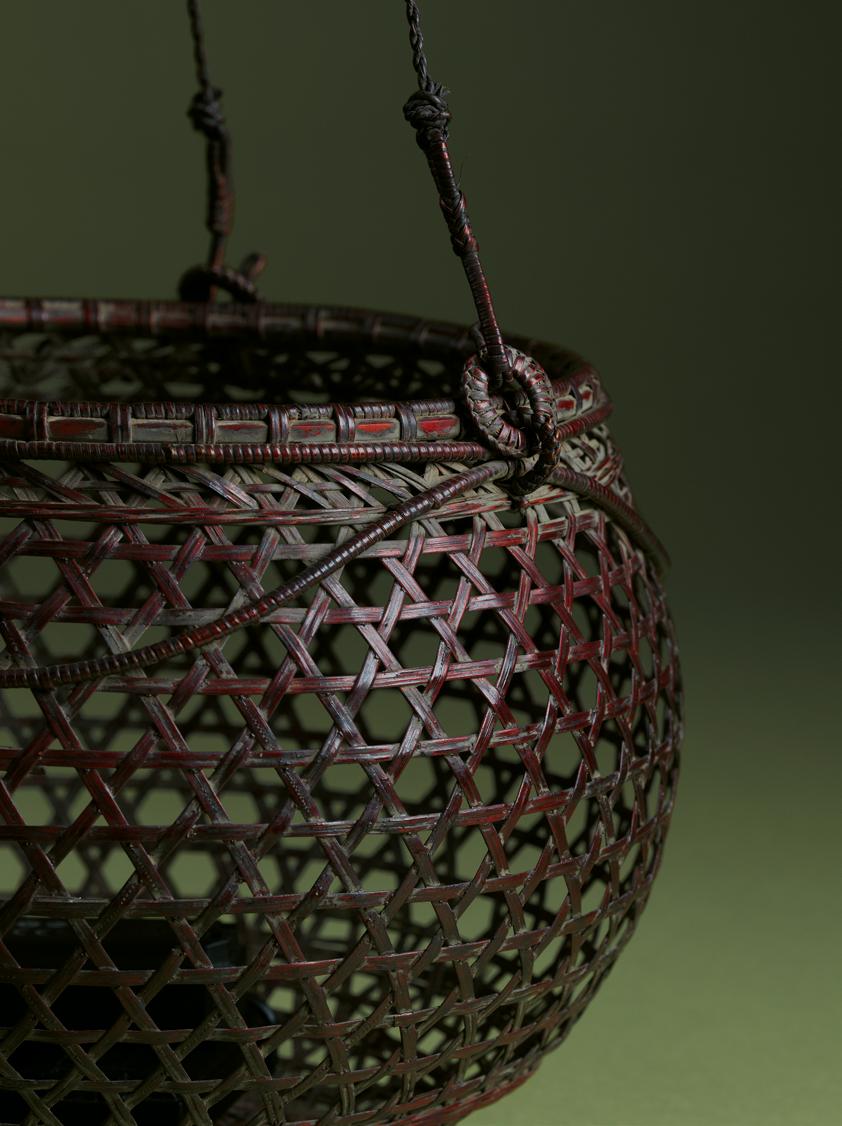
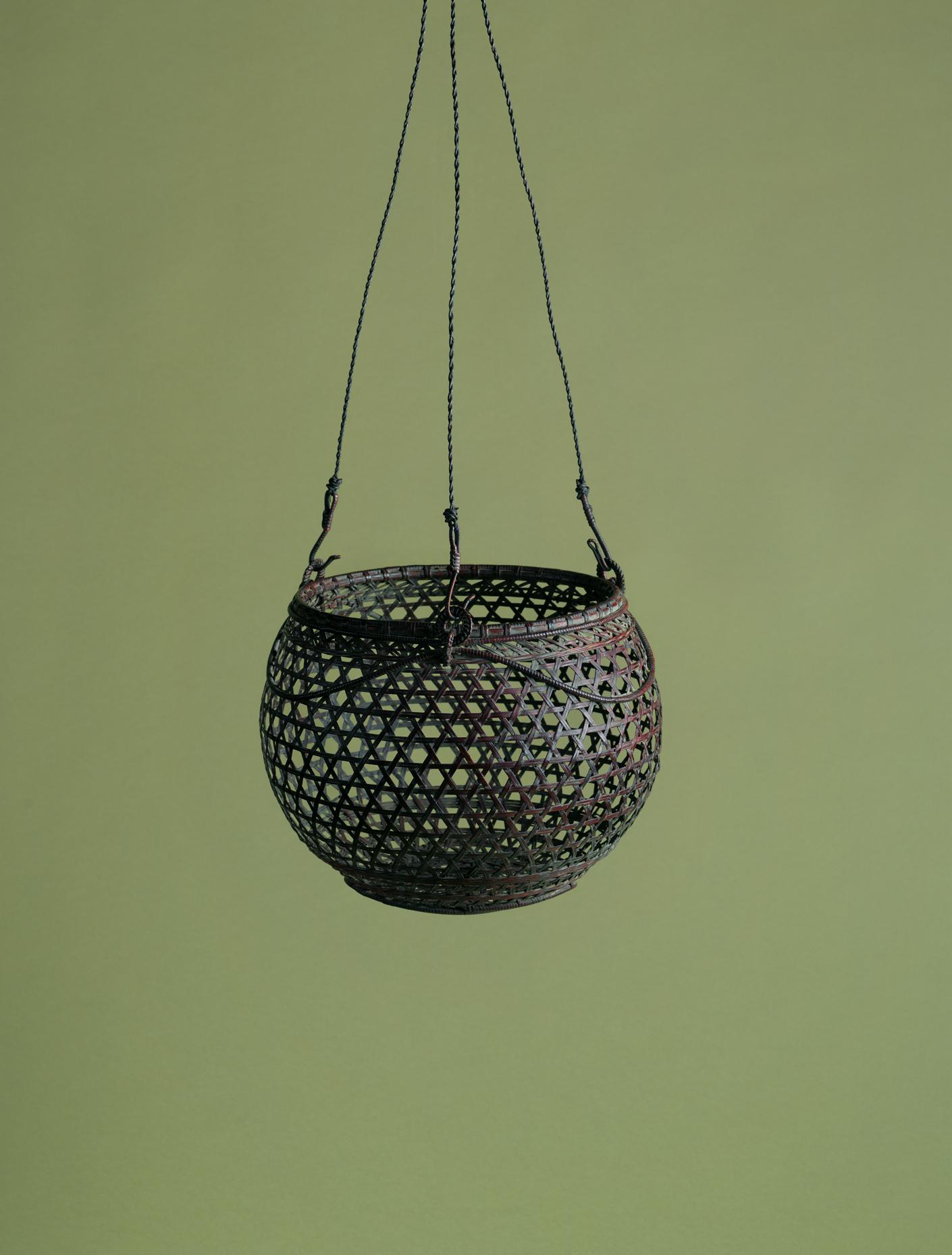
Katsushiro Sōhō (b. 1934)
Kagerō ( Heat Haze ) hanging flower basket, 1968
Bamboo, rattan and staining; hexagonal plaiting, knotting

Height: 33.0cm (108.0cm)
Width: 33.5cm
Depth: 33.0cm
Box inscription: Tsurihanakago (hanging flower basket); Kagerō ( Heat Haze ); Sōhō ; Seal: Sōhō

Honma Hideaki (b. 1959)
Sō ( Pair ), 2008
Signed: Hide
Men’yadake bamboo and rattan; twill plaiting, bending

Height: 68.0cm
Width: 117.2cm
Depth: 27.4cm
Box inscription: 2008nen; Sō (Pair); Hideaki; Seal: Hideaki
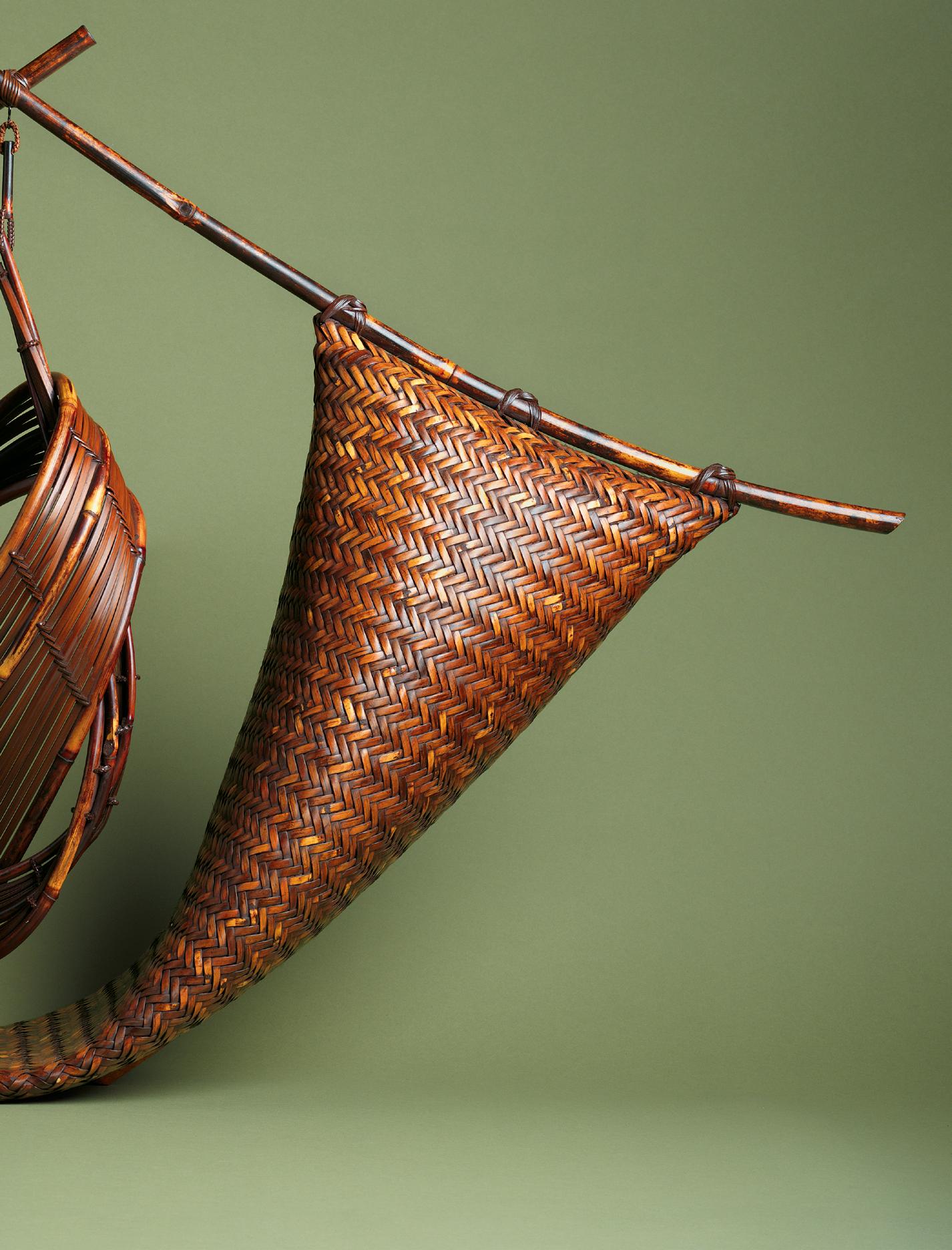
Bamboo artists featured in the present exhibition
Fukunishi Ryōsei (b. 1941)
Born in Nara Prefecture, Fukunishi Ryōsei started his bamboo apprenticeship in Uda City, Nara Prefecture. He has won numerous awards including at the Japan Traditional Art Crafts Exhibition, Kinki Region Version (every year from 2002), the Japan Traditional Art Crafts Exhibition and the Japan Traditional Art Crafts Woodwork Exhibition. In 2011, he received an award from the Shiga Prefecture Education Board.
Honda Shōryū (b. 1951)
Born in Iriki Town, Kagoshima Prefecture, Kyushu, Honda Shōryū is a graduate of the Oita Prefecture Bamboo Training Institute and he trained under Kadota Nikō, a well-known artist. He was awarded the Oita Prefectural Governor’s Prize in the Western Japan Crafts Association Exhibition in 1981 and 1986. From the late 1980s onwards, his works have been regularly selected for the Japan Traditional Art Crafts Exhibition. In 2000 he was admitted to the prestigious Japan Fine Arts Exhibition (Nitten) and he has since shown there ten times. He was a finalist in the Cotsen Bamboo Awards in 2000, 2002 and 2004. In 2003, he won the ‘Newcomer’ Award at the 42 nd Japan Contemporary Arts and Crafts Exhibition. His work has featured in The Next Generation exhibition at the Asian Art Museum, San Francisco, 2007; Japanese Bamboo Art: The Abbey Collection , at the Metropolitan Museum of Art, New York in 2017; and Fendre l’Air, L’art du bamboo au Japan , at the Musée du Quai Branly-Jacques Chirac, Paris in 2018. Some of his abstract sculptures are distinguished by the use of the sensuji or ‘thousand line’ technique using multiple strips of stained bamboo. His works are in the collections of institutions including the Metropolitan Museum of Art, New York; the Museum of Art and Design, New York; the Museum of Fine Arts, Boston; the Asian Art Museum, San Francisco; the Philadelphia Museum of Art, Philadelphia; Herbert F. Johnson Museum of Art, Cornell University, Ithaca; Beppu City Bamboo Craft Centre, Beppu.
Honma Hideaki (b. 1959)
Honma Hideaki comes from a family of bamboo artisans. His grandfather started the family bamboo craft business, Honma Kogei, in 1923 on Sado Island, Niigata Prefecture. An accident while serving in the Japanese air force left Honma Hideaki with vision in only one eye. Subsequently, he was adopted by his uncle, Honma Kazuaki (1930 - 2017), the well-known bamboo master and began training with him. In 1991 Honma Hideaki participated in the Japan Contemporary Arts and Crafts Exhibition and in 1992, his work was first accepted into the Japan Fine Arts Exhibition (Nitten). He went on to become a judge for the Japan Contemporary Arts and Crafts Exhibition and to serve on the council. He has also been awarded the Tokusen Prize twice at the Nitten (in 2014 and 2018). His work features a range of plaiting techniques, often combined with lengths of unsplit, dramatically curving, bent bamboo on the outer edges. Also notable is his use of men’yadake bamboo, a mottled, pliable variety, which is only grown on Sado Island. He draws inspiration from his island home and has created a series of sculptures inspired by the sea and waves. His works are in the collections of a number of institutions including the Art Institute of Chicago, Chicago and the Asian Art Museum, San Francisco.
Iizuka Shōkansai was the second son of the celebrated bamboo master Iizuka Rōkansai. He graduated from Tokyo School of Fine Arts in 1942, having specialised in oil painting. After serving his country in World War II and following the untimely death in 1943 of his older brother, who was a bamboo artist, he began an apprenticeship under his father. In 1949, he assumed his deceased brother’s art name, Shōkansai. He presented his work at the Japan Fine Arts Exhibition (Nitten) starting in 1947 and received prizes in 1953, 1954 (The Grand Prize) and 1960 (The Chrysanthemum Award). He also exhibited at the Japanese Traditional Art Crafts Exhibition and was awarded the Minister of Education’s Prize in 1974. His works are notable for the innovative use of techniques such as bundle plaiting and sō (informal) plaiting. He was designated a Living National Treasure in 1982, the second bamboo artist to attain this prestigious status.
A native of Tochigi Prefecture, Katsushiro Sōhō began his career by making bamboo farm tools after graduating from secondary school. In his mid-teens he trained with a local bamboo craftsman Kikuchi Yoshii; this was followed by apprenticeships with the bamboo master, Yagisawa Keizō (1927 - 2006) and later with Saitō Bunseki (1910 - 1991). Katsushiro Sōhō’s work was first selected for the 15 th Japan Traditional Art Crafts Exhibition in 1967. He later became an evaluator and judge for that series of exhibitions and received the NHK Chairman’s Award in 1997. In 2005, he was designated a Living National Treasure in the field of bamboo art. His work was one of the ‘Eighty-three Selected Treasures of the Heisei Era’ included in the 2017 post-restoration re-dedication of the East Pagoda of the Yakushiji Temple, Nara. Recent exhibitions devoted to his art have been held at the Ibara Municipal Denchu Art Museum (2017) and at the Tochigi Prefectural Museum of Fine Arts (2020). His works are in the collections of numerous institutions including Ibara Municipal Denchu Art Museum, Ibara City; the Tochigi Prefectural Museum of Fine Arts, Utsunomiya, Tochigi; the National Museum of Modern Art, Tokyo; the Metropolitan Museum of Art, New York; and the Asian Art Museum, San Francisco.
From the Kansai area, Maeda Chikubōsai I was one of the most distinguished and important bamboo artists of the early twentieth century. He worked with Tanabe Chikuunsai I (18771937) from around 1912, making baskets for the export market. His early production included ‘Chinese style’ karamono baskets but he later began to experiment with bamboo roots to create a more rustic feel to his pieces, with a focus on individual expression. His access to a good supply of susudake (smoked bamboo) meant that this darker, patinated bamboo was often a feature of his work. Many of his creations were presented to the Emperor and the imperial family. His works are also in the collections of numerous Western institutions including the Metropolitan Museum of Art, New York; the Saint Louis Art Museum, Saint Louis; and the Minneapolis Institute of Art, Minneapolis.
Mimura
Born in Tokyo, Mimura Chikuhō trained initially as a musician and studied the trombone at the conservatoire in Heidelberg. He studied at both the well-known bamboo training school and the research institute at Oita and continued with two and a half years of study under the Beppu-based bamboo master Yufu Shōhaku. His artist name Chikuhō, meaning ‘Bamboo Shoot’ was conferred on him by Yufu Shōhaku in 2000. From the early 2000s, Mimura has exhibited at a number of venues in the West, including at the Asian Art Museum, San Francisco in 2003 and he was selected as a finalist at the ‘Next Generation Festival’, San Francisco in 2007. In 2014, he moved to Kunisaki and started the Chikuhō Bamboo Art Lab. Inspired by nature and the elements, especially the wind and waves, some of his sculptural works use tonal contrasts created by thin strips of bamboo woven in different directions ( yatara-ami ). His works are in the collections of the following institutions: the Asian Art Museum, San Francisco; the National Gallery of Victoria, Melbourne; the Philadelphia Museum of Art, Philadelphia; the Minneapolis Institute of Art, Minneapolis.
Sakaguchi Sōunsai (1899 - 1967)
Sakaguchi Sōunsai apprenticed with the celebrated bamboo master, Tanabe Chikuunsai I (1877 - 1937), becoming one of his top students. In 1929, he was one of the first two bamboo artists to exhibit in the government-sponsored Imperial Art Academy Exhibition (Teiten). His submission was a ‘modern’ style of fruit tray inspired by the reflection of moon in water and named Suigetsu ( Water Moon ), now in the collection of the Metropolitan Museum of Art, New York. One of his students was the bamboo artist Minoura Chikuhō (1934 - 2010).
Shiotsuki Juran (1948 - 2016)
Born on Shukoku Island, Ehime Prefecture, Shiotsuki Juran studied bamboo craftsmanship at the Beppu Industrial Art Crafts Institute and subsequently trained under the bamboo artist Ichihara Kaunsai (1916 - 1995). He started exhibiting his works in 1976 and first showed at the Japan Traditional Art Crafts Exhibition in 1982. By the early 1990s, he stopped showing at
traditional exhibition venues and began focusing on more experimental pieces, some of which have inspired young bamboo artists from Kyushu and the Kansai region. His works are in the collections of institutions including the Metropolitan Museum of Art, New York.
Shōno Tokuzō (b. 1942)
Shōno Tokuzō is the son of Shōno Shōunsai (1904 - 1974), the first bamboo artist to be designated a Living National Treasure. After graduating in sculpture from Musashino Art University, Tokyo, in 1964, Tokuzō apprenticed with his father for ten years. Like his father, he harvests his own bamboo where he lives in Oita Prefecture and he prepares it by using heat to draw out the natural oils. The painstaking process results in bamboo that is pleasing in colour. His works are in the collections of institutions including the Metropolitan Museum of Art, New York; and the Philadelphia Museum of Art, Philadelphia.
Sugiura Noriyoshi (b. 1964)
Sugiura Noriyoshi, a native of Sendai, Honshu in north-east Japan, decided at the age of thirty-three to train as a bamboo artist. He studied at the Oita Prefecture Bamboo Training Institute and the Beppu Industrial Art Crafts Institute, before starting his apprenticeship with Watanabe Chikusei II (b. 1932), followed by a period of study with Okazaki Chikubōsai II (b. 1933). In 2004, he exhibited his work at the Japan Traditional Art Crafts Exhibition. A flower basket created by Sugiura was presented to the Emperor of Japan during the 2008 Oita National Sports Festival. His works are in the collections of the Museum of Fine Arts, Boston; the Clark Center for Japanese Art & Culture, Hanford; the Anjyo Citizens Gallery; and Beppu City Bamboo Craft Centre, Beppu.
Tanabe Chikuunsai I (1877 - 1937)
This celebrated bamboo master was the third son of the physician to a lord of the Amagasaki domain, near Osaka. His interest in bamboo started at an early age and by twelve, he was apprenticed to the bamboo master Wada Waichisai I (1851 - 1901). The name Chikuunsai (Bamboo Cloud Studio) was bestowed upon him by his master in acknowledgement of his talent and by 1903 he had received an award at the Fifth National Industrial Exhibition. His study of the arts included attaining master status in both flower arranging and sencha tea ceremony, both of which also informed his bamboo creations and placed him at the heart of literati artistic circles in Sakai City, where he was based from 1910. Considered one of the founders of modern Japanese bamboo art, his work ranges from ‘Chinese-style’ baskets to innovative designs using his own styles and techniques. He is also celebrated for his baskets which recycle and incorporate old bamboo arrow shafts. His legacy is seen in his fourgenerational family lineage of bamboo artists bearing his name and his mentorship of younger artists including Sakaguchi Sōunsai and Ueda Shōunsai.
Tanabe Chikuunsai II (1910 - 2000)
Like his father before him, Tanabe Chikuunsai II started working with bamboo as a very young child. Aged five he demonstrated his skill at hexagonal plaiting during an exhibition of his father’s works and by fifteen he had held his own exhibition. He was celebrated for his technical skills and innovation, with a focus on baskets and their uses. His individual style of openwork hexagonal plaiting is particularly admired. By 1931, his work was included in the government-sponsored Imperial Art Academy Exhibition (Teiten), followed by participation in the Japan Fine Arts Exhibition (Nitten) and others. He served as a juror and then as a councillor of the Nitten and was honoured with the Nitten Special Recognition Prize in 1952. He assumed the title of Chikuunsai II in 1937 following his father’s death. In 1991, he passed the Chikuunsai name to his eldest son and took the name of Itchikusai for himself.
Tanabe Chikuunsai IV (b. 1973)
Tanabe Chikuunsai IV is the fourth generation of an illustrious family of bamboo masters from Sakai, Osaka Prefecture. Following a degree in sculpture at the Tokyo University of the Arts, he began an apprenticeship under his father, the renowned bamboo master, Tanabe Chikuunsai
III (1940 - 2014) and he himself assumed the title of Tanabe Chikuunsai IV in 2017. Tanabe Chikuunsai IV has exhibited widely in Japan and abroad, in both individual and group shows. In 2012, he was selected by the National Policy Unit in Japan as part of the ‘Global Messengers of Japan Project’. Recent participations include the travelling exhibition Japanese Bamboo Art: The Abbey Collection which started at the Metropolitan Museum of Art, New York in 2017, where his large bamboo installation graced the entrance and Fendre l’Air, L’art du bamboo au Japan , at the Musée du Quai Branly-Jacques Chirac in Paris in 2018. In 2021, he won the first Mingei Bamboo Prize. His works are in the collections of institutions including the Asian Art Museum, San Francisco; the Seattle Art Museum, Seattle; the Museum of Fine Arts, Boston; Musée Guimet, Paris; the Philadelphia Museum of Art, Philadelphia; the Metropolitan Museum of Art, New York; and the Imperial Household Agency, Japan.
Tanabe Kōunsai (1898 - 1987)
Tanabe Kōunsai was a member of the famous Chikuunsai family of bamboo artists: he was a cousin of Chikuunsai II (1910 - 2000). Aged around seventeen, Tanabe Kōunsai, together with his younger cousin Chikuunsai II, aged five, demonstrated his skill at hexagonal plaiting during an exhibition of the work of Chikuunsai I (1877 - 1937), held at the Mitsukoshi Department Store in Osaka. No further information is available regarding this member of the Tanabe lineage, but a basket in the Naej collection signed Tanabe Kōunsai is dated 1924.
No documentary information has come to light regarding this artist. The majority of his surviving works appear to be charcoal baskets.
Wada Waichisai III was the grandson of Wada Waichisai I (1851 - 1901), one of the key figures in bamboo art of the Kansai region. He was apprenticed to his father, Wada Waichisai II (1877 - 1933) and succeeded to the Waichisai name on the latter’s death in 1933. He started his career as an independent artist in Tokyo and an early solo show at the Mitsukoshi Gallery was visited by members of the imperial family. By 1928, Wada Waichisai III returned to Kobe; in 1935, a flower basket was commissioned from him by the city of Kobe for presentation to the Showa emperor. During World War II, the Japanese government issued restrictions on the production and sale of ‘luxury’ goods and Wada Waichisai III was one of the few artists allowed to continue working. However, he lost both his home and his son during the bombing of Kobe and relocated to Sumoto City on Awaji Island. He continued his work on the island after the war and served as a judge for the Sumoto City Art Exhibition.
Born in Beppu, Oita Prefecture, Yufu Shōhaku studied under his father, the bamboo master Yufu Chikuryū. He has exhibited and received awards at various exhibitions including at the Japan Traditional Art Crafts Exhibition, the Oita Prefecture Art Exhibition and the Oita Craft Exhibition. In 2018, he was designated a ‘Special Person of Cultural Merits’ by Beppu City and in 2021, he was designated a ‘Person of Cultural Merits’ for the Traditional Crafts Industry by the Kyushu Ministry of Economics, Trade and Industry. He has also been certified as a ‘Firstclass Skilled Technician’ and a ‘Traditional Craftsman’ by the Association for the Promotion of Traditional Craft Industries. Yufu’s work is distinguished by his technique of yatara-ami (freestyle plaiting) incorporating large pieces of bamboo culm and rhizome. An important part of his practice currently includes training the younger generation of bamboo artists in this technique.
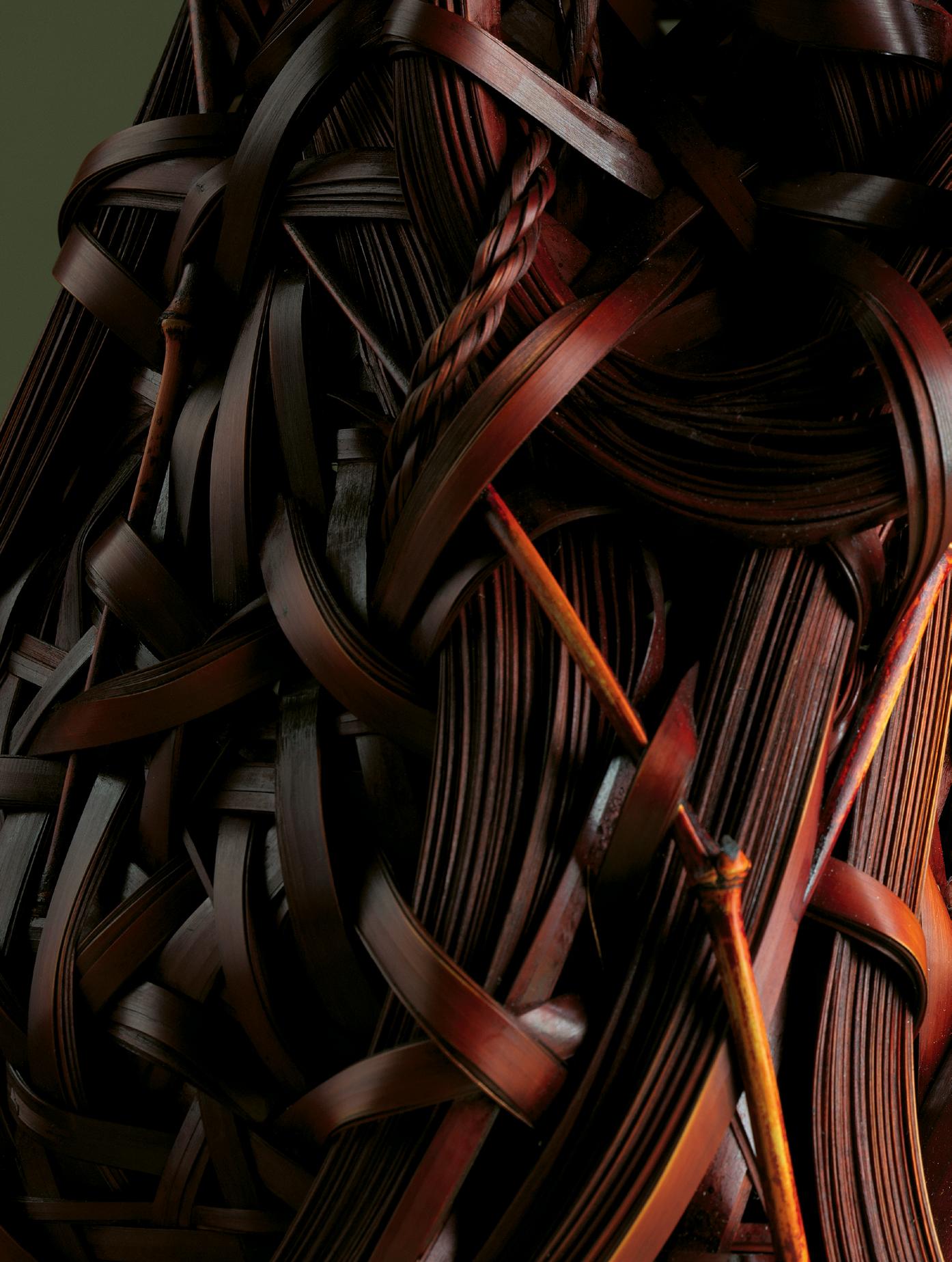

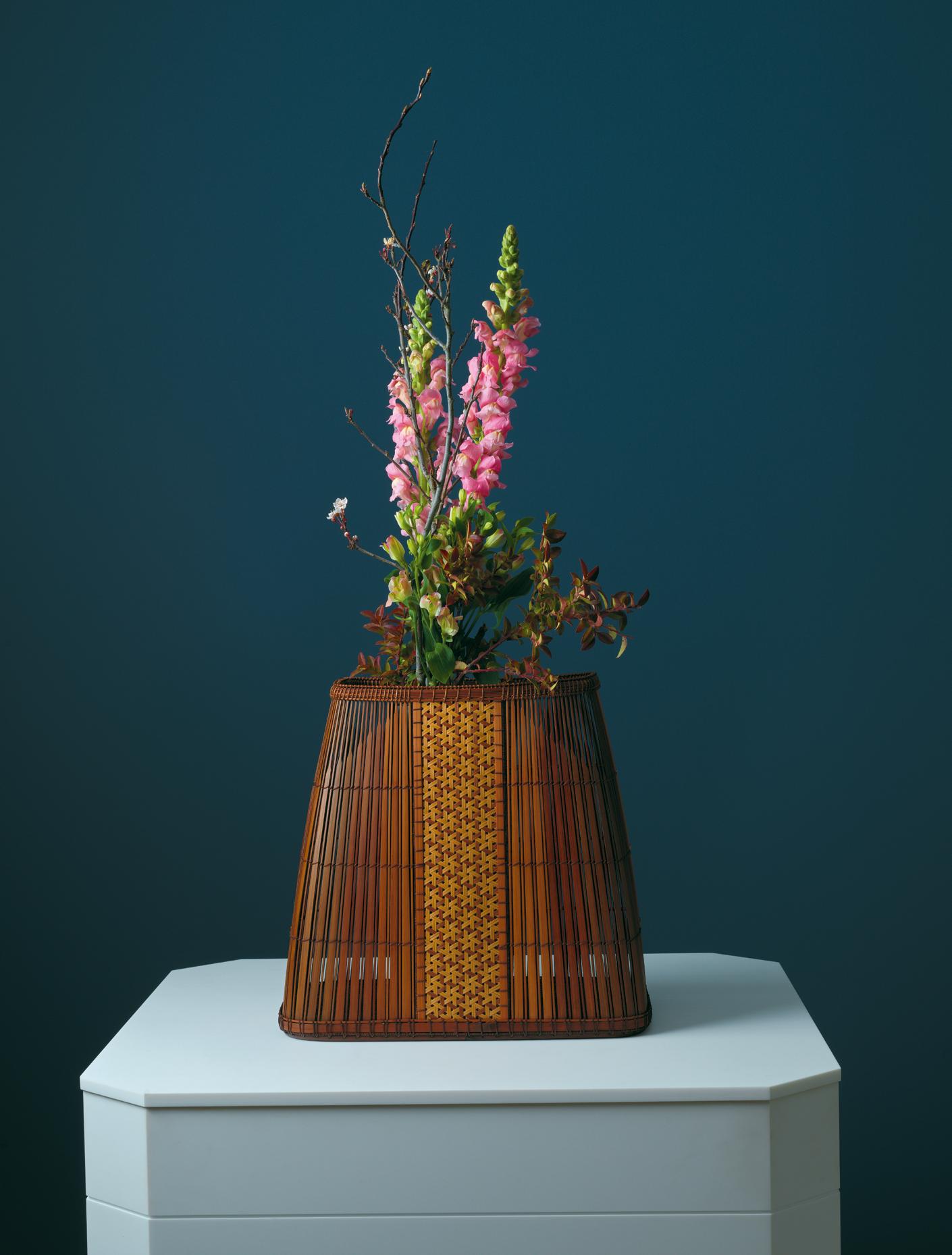
Works of art purchased from Eskenazi Ltd. London, are now in the following museum collections:
Ackland Art Museum, North Carolina
Arita Porcelain Park Museum, Saga
Art Gallery of New South Wales, Sydney
Art Gallery of South Australia, Adelaide
Art Institute of Chicago, Chicago
Arthur M. Sackler Gallery, Washington, DC
Ashmolean Museum, Oxford
Asia House, Mr and Mrs John D Rockefeller 3rd Collection, New York
Asian Art Museum of San Francisco, San Francisco
Asian Civilisations Museum, Singapore
Baltimore Museum of Art, Baltimore
Birmingham Museum of Art, Alabama
British Museum, London
Brooklyn Museum, New York
Chang Foundation, Taibei
Chung Young Yang Embroidery Museum, Sookmyung
Women’s University, Seoul, Korea
Cincinnati Art Museum, Cincinnati
Cleveland Museum of Art, Cleveland
Columbus Museum of Art, Columbus
Corning Museum of Glass, Corning
Dallas Museum of Art, Dallas
Dayton Art Institute, Dayton
Denver Art Museum, Denver
Designmuseum Danmark, Copenhagen
Didrichsen Art Museum, Helsinki
Fitzwilliam Museum, Cambridge
Flagstaff House Museum of Teaware, Hong Kong
Freer Gallery of Art, Washington, DC
Hagi Uragami Museum, Hagi
Hakone Museum of Art, Hakone
Harvard Art Museums, Cambridge, Massachusetts
Hetjens Museum, Düsseldorf
Hong Kong Museum of Art, Hong Kong
Honolulu Museum of Art, Honolulu
Idemitsu Museum of Arts, Tokyo
Indianapolis Museum of Art, Indianapolis
Israel Museum, Jerusalem
Istituto Italiano per il Medio ed Estremo Oriente, Rome
Kimbell Art Museum, Fort Worth
Kuboso Memorial Museum of Arts, Izumi, Osaka
Los Angeles County Museum of Art, Los Angeles
Louvre Abu Dhabi, Abu Dhabi
M Woods Museum, Beijing
Matsuoka Museum of Art, Tokyo
Metropolitan Museum of Art, New York
Miho Museum, Shigaraki
Minneapolis Institute of Art, Minneapolis
MOA Museum of Art, Atami
Musée Ariana, Geneva
Musée des arts asiatiques, Nice
Musée national des arts asiatiques Guimet, Paris
Musées royaux d’Art et d’Histoire, Brussels
Museum für Asiatische Kunst, Berlin
Museum für Kunst und Gewerbe, Hamburg
Museum für Lackkunst, Münster
Museum für Ostasiatische Kunst, Cologne
Museum of Fine Arts, Boston
Museum of Fine Arts, Houston
Museum of Islamic Art, Doha
Museum of Oriental Ceramics, Osaka
Museum Rietberg, Zurich
National Gallery of Australia, Canberra
National Gallery of Canada, Ottawa
National Gallery of Victoria, Melbourne
National Museum of Singapore, Singapore
Nelson-Atkins Museum of Art, Kansas City
Nezu Museum, Tokyo
Norton Simon Museum, Pasadena
Östasiatiska Museet, Stockholm
Princeton University Art Museum, Princeton
Royal Ontario Museum, Toronto
St. Louis Art Museum, St. Louis
Seattle Art Museum, Seattle
Shanghai Museum, Shanghai
Speed Art Museum, Louisville
State Administration of Cultural Heritage, Beijing
Toguri Museum of Art, Tokyo
Tokyo Fuji Art Museum, Tokyo
Tokyo National Museum, Tokyo
Tsui Museum of Art, Hong Kong
Tsz Shan Monastery Buddhist Art Museum, Hong K ong
Victoria and Albert Museum, London
Virginia Museum of Fine Arts, Richmond
Worcester Art Museum, Worcester
Zhiguan Museum of Fine Art, Beijing
March 1972 Inaugural exhibition Early Chinese ceramics and works of art.
June 1972 Georges Rouault, an exhibition arranged by Richard Nathanson.
June 1973 Ancient Chinese bronze vessels, gilt bronzes and early ceramics.
November 1973 Chinese ceramics from the Cottle collection.
December 1973 Japanese netsuke formerly in the collection of Dr Robert L Greene.
June 1974 Early Chinese ceramics and works of art.
November 1974 Japanese inro - from the collection of E A Wrangham.
May 1975 Japanese netsuke and inro - from private collections.
June 1975 Ancient Chinese bronzes from the Stoclet and Wessén collections.
June 1976 Chinese jades from a private collection.
June 1976 Michael Birch netsuke and sculpture.
June 1976 Japanese netsuke and inro - from private collections.
June 1977 Ancient Chinese bronze vessels, gilt bronzes and sculptures; two private collections, one formerly part of the Minkenhof collection.
June 1978 Ancient Chinese sculpture.
June 1978 Michael Webb netsuke.
June 1978 Eighteenth to twentieth century netsuke.
June 1979 Japanese netsuke from private collections.
June 1980 Jap anese netsuke from private collections and Michael Webb net suke.
July 1980 Ancient Chinese bronzes and gilt bronzes from the Wessén and other collections.
December 1980 Chinese works of art from the collection of J M A J Da wson.
October 1981 Japanese netsuke and inro - from the collection of Professor and Mrs John Hull Grundy and other private collections.
December 1981 Ancient Chinese sculpture.
October 1982 Japanese inro - from private collections.
November 1983 Michael Webb, an English carver of netsuke.
October 1984 Japanese netsuke, ojime, inro - and lacquer-ware.
June 1985 Ancient Chinese bronze vessels, gilt bronzes, inlai d bronzes, silver, jades, ceramics – Twenty five years.
December 1986 Japanese netsuke, ojime, inro - and lacquer-ware.
June 1987 Tang.
June 1989 Chinese and Korean art from the collections of Dr Franco Vannotti, Hans Popper and others.
November 1989 Japanese lacquer-ware from the Verbrugge collection.
December 1989 Chinese art from the Reach family collection.
May 1990 Japanese netsuke from the Lazarnick collection.
June 1990 Ancient Chinese sculpture from the Alsdorf collection and others.
November 1990 The Charles A Greenfield collection of Japanese lacquer.
June 1991 Inlaid bronze and related material from pre-Tang China.
November 1992 Japanese lacquer-ware – recent acquisitions.
December 1992 Chinese lacquer from the Jean-Pierre Dubosc collection and others.
June 1993 Early Chinese art from tombs and temples.
June 1993 Japanese netsuke from the Carré collection.
June 1994 Yuan and early Ming blue and white porcelain.
June 1995 Early Chinese art: 8th century BC – 9th century AD.
October 1995 Adornment for Eternity, loan exhibition from the Denver Art Museum.
June 1996 Sculpture and ornament in early Chinese art.
November 1996 Japanese inro - and lacquer-ware from a private Swedish collection.
March 1997 Ceramic sculpture from Han and Tang China.
June 1997 Chinese Buddhist sculpture.
June 1997 Japanese netsuke, ojime and inro - from the Dawson collection.
November 1997 Japanese netsuke – recent acquisitions.
March 1998 Animals and animal designs in Chinese art.
June 1998 Japanese netsuke, ojime and inro - from a private European collection.
November 1998 Chinese works of art and furniture.
March 1999 Ancient Chinese bronzes and ceramics.
November 1999 Ancient Chinese bronzes from an English private collection.
March 2000 Masterpieces from ancient China.
November 2000 Chinese furniture of the 17th and 18th centuries.
March 2001 Tang ceramic sculpture.
November 2001 Chinese ceramic vessels 500 – 1000 AD.
March 2002 Chinese Buddhist sculpture from Northern Wei to Ming.
November 2002 Two rare Chinese porcelain fish jars of the 14th and 16th centuries.
March 2003 Chinese works of art from the Stoclet collection.
November 2003 Song: Chinese ceramics, 10th to 13th century.
March 2004 Chinese Buddhist figures.
November 2004 A selection of Ming and Qing porcelain.
March 2005 Ancient Chinese bronzes and sculpture.
November 2005 Song ceramics from the Hans Popper collection.
March 2006 A selection of early Chinese bronzes.
June 2006 Recent paintings by Arnold Chang.
November 2006 Chinese porcelain from the 15th to the 18th century.
March 2007 Song: Chinese ceramics, 10th to 13th century (part 3).
November 2007 Mountain landscapes by Li Huayi.
March 2008 Chinese sculpture and works of art.
October 2008 Chinese ceramics and stone sculpture.
October 2009 Seven classical Chinese paintings.
March 2010 Trees, rocks, mist and mountains by Li Huayi.
November 2010 Fiftieth anniversary exhibition: twelve Chinese masterworks.
March 2011 Early Chinese metalwork in gold and silver; works of art of the Ming and Qing dynasties.
November 2011 Chinese huanghuali furniture from a private collection.
November 2011 The twelve animals of the zodiac by Li Huayi.
November 2012 Qing porcelain from a private collection.
October 2013 Junyao.
October 2013 Bo Ju Gui: an important Chinese archaic bronze.
October 2014 Waterfalls, rocks and bamboo by Li Huayi.
October 2014 Chinese sculpture c. 500 - 1500.
May 2015 Principal wares of the Song period from a private collection.
October 2015 Transfigured echoes: recent paintings by Liu Dan.
October 2016 Recent paintings by Zeng Xiaojun.
November 2016 Early Chinese art from private collections.
November 2017 Six Dynasties art from the Norman A. Kurland collection, Part one.
May 2018 Song: Chinese ceramics, 10th to 13th century (part 5).
May 2018 Gogottes: a rift in time.
November 2018 Six Dynasties art from the Norman A. Kurland collection, Part two.
November 2019 Room for study: fifty scholars’ objects.
October 2021 Tang: ceramics, metalwork and sculpture.
June 2022 Contemporary bamboo: masters from Japan.
June 2022 Gogottes: unfolding time.
October 2022 50 years of exhibitions: five masterpieces on loan from a private family coll ection .
